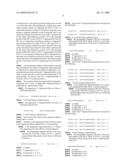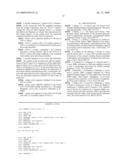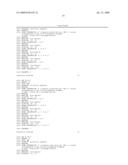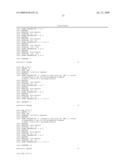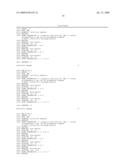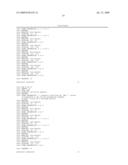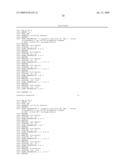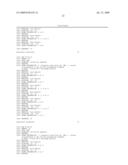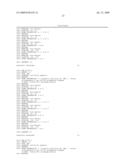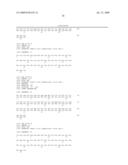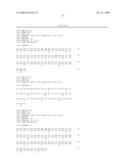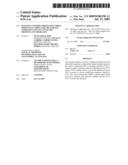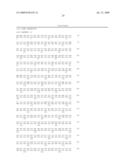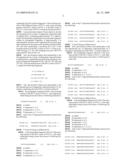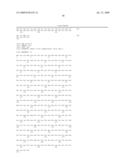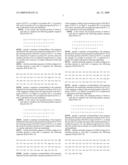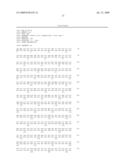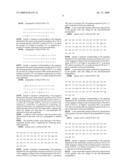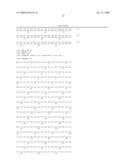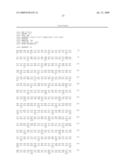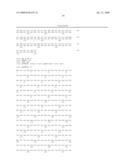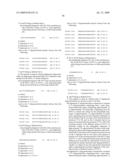Patent application title: OLIGONUCLEOTIDES ORIGINATING FROM SEQUENCES CODING FOR THE SURFACE COMPONENT OF PTLV ENVELOPE PROTEINS AND THEIR USES
Inventors:
Felix Jinhyun Kim (Montpellier, FR)
Nicolas Gabriel Albert Manel (Montpellier, FR)
Khamous Marc Michel Sitbon (Montpellier, FR)
Assignees:
CENTRE NATIONAL DE LA RECHERCHE SCIENTIFIQUE
UNIVERSITE DE MONTPELIER II
IPC8 Class: AC12Q170FI
USPC Class:
435 5
Class name: Chemistry: molecular biology and microbiology measuring or testing process involving enzymes or micro-organisms; composition or test strip therefore; processes of forming such composition or test strip involving virus or bacteriophage
Publication date: 2009-07-23
Patent application number: 20090186338
Claims:
1. A method for implementing processes for detecting any strain of PTLV,
namely any strain belonging to HTLV-1, HTLV-2, STLV-1, STLV-2, and
STLV-3, as well as any strain of virus belonging to PTLVs, namely any
strain the amino acid sequence of which is deduced from the nucleotide
sequence coding for the amino-terminal region of the SU has a homology
level of at least approximately 30% with the amino acid sequences coded
by the corresponding nucleotide sequences in PTLVs, in particular for
detecting novel variants of PTLVs, or a virus comprising sequences
belonging to the SU of PTLVs,with pairs of degenerate oligonucleotides in
5' and 3' orientation originating from the nucleotide sequences coding
for the amino-terminal region of the surface component (SU) of the
envelope proteins of the viruses of T lymphomas/leukaemias in primates,
collected together under the designation PTLV, these viruses also being
designated HTLV in man and STLV in the monkey, namely the region
corresponding to the protein fragments delimited on the N-terminal side
by an amino acid situated between positions 75 to 90, and on the
C-terminal side by an amino acid situated between positions 230 to 245 of
the envelope proteins of the different strains of PTLVs, or a virus
carrying the sequences belonging to the SU of PTLVs,said processes
comprising:a) an amplification stage of a target nucleic acid in a
biological sample capable of containing PTLVs, and with the
abovementioned degenerate 5' and 3' oligonucleotides used as primers, of
the number of copies of nucleotide fragments delimited in position 5' by
the degenerate oligonucleotide in 5'orientation, and in position 3' by
the degenerate oligonucleotide in 3' orientation, andb) an identification
stage of the strain of PTLV contained in the biological sample from the
abovementioned amplified nucleotide fragments.
2. The method of claim 1, wherein oligonucleotides are chosen from those comprising approximately 15 to approximately 30 nucleotides originating from the nucleotide sequences coding for protein fragments delimited on the N-terminal side by an amino acid situated between positions 75 to 90, and on the C-terminal side by an amino acid situated between positions 230 to 245 of the envelope proteins of the different strains of PTLVs, such that the envelope protein of the MT-2 strain of HTLV-1 represented by SEQ ID NO: 43, or the NRA strain of HTLV-2 represented by SEQ ID NO: 45, or the strain of STLV-3 represented by SEQ ID NO: 47, said degenerate oligonucleotides comprising a mixture of oligonucleotides originating from sequences coding for a determined region of approximately 5 to 10 amino acids of the envelope proteins of the different strains of PTLV, and which differ from each other by the substitution of at least one nucleotide by another in a manner such that each oligonucleotide is capable of coding for the abovementioned determined region originating from the protein fragments of the envelope proteins of the different strains of PTLVs, such as the envelope protein of the MT-2 strain of HTLV-1, or the NRA strain of HTLV-2, or the strain of STLV-3 which are mentioned above.
3. The method of claim 1, wherein pairs of degenerate oligonucleotides comprise approximately 15 to approximately 30 nucleotides originating from nucleotide sequences coding for polypeptide fragments of approximately 5 to approximately 10 amino acids originating from protein fragments delimited by the amino acids situated at positions 80 to 245, and more particularly at positions 83 to 241, of the envelope protein of the MT-2 strain of HTLV-1 represented by SEQ ID NO: 43.
4. The method of claim 1, wherein pairs of degenerate oligonucleotides originate from nucleotide sequences coding for the polypeptide fragments 83-88, 140-145, 222-228, and 237-241, of the envelope protein of the MT-2 strain of HTLV-1, namely the following fragments:i) the polypeptide fragments 83-88 represented by SEQ ID NO: 1, and 222-228 represented by SEQ ID NO: 3, orii) the polypeptide fragments 83-88 represented by SEQ ID NO: 1, and 237-241 represented by SEQ ID NO: 4, oriii) the polypeptide fragments 140-145 represented by SEQ ID NO: 2, and 222-228 represented by SEQ ID NO: 3, oriv) the polypeptide fragments 140-145 represented by SEQ ID NO: 2, and 237-241 represented by SEQ ID NO: 4, orv) the polypeptide fragments 222-228 represented by SEQ ID NO: 3, and 237-241 represented by SEQ ID NO: 4,of the envelope protein of the MT-2 strain of HTLV-1.
5. The method of claim 4, wherein degenerate oligonucleotides are degenerate oligonucleotides in 5' orientation originating from the DNA (+) strand coding for:the polypeptide fragment 83-88 of the envelope protein of the MT-2 strain of HTLV-1, said oligonucleotides being chosen from those of following formula (I): TABLE-US-00052 TAYBTNTTYCCNCAYTGG (I) SEQ ID NO:5
in which:Y represents C or T,B represents C, G or T,N represents A, C, G or T,such as the 5' oligonucleotide primers chosen from the following: TABLE-US-00053 PTLVE5'83a TAYBTNTTYCCNCACTGG SEQ ID NO:6 PTLVE5'83b TAYBTNTTYCCNCATTGG SEQ ID NO:7
Y, B and N being as defined above,the polypeptide fragment 140-145 of the envelope protein of the MT-2 strain of HTLV-1, said oligonucleotides being chosen from those of following formula (II): TABLE-US-00054 AAYTTYACNCARGARGT (II) SEQ ID NO:8
in which:Y represents C or T,R represents A or G,N represents A, C, G or T,such as the 5' oligonucleotide primers chosen from the following: TABLE-US-00055 PTLVE5'140a AAYTTYACNCAAGAAGT SEQ ID NO:9 PTLVE5'140b AAYTTYACNCAGGAAGT SEQ ID NO:10 PTLVE5'140c AAYTTYACNCAAGAGGT SEQ ID NO:11 PTLVE5'140d AAYTTYACNCAGGAGGT SEQ ID NO:12
Y and N being as defined above.
6. The method of claim 4, wherein degenerate oligonucleotides are degenerate oligonucleotides in 3' orientation originating from the DNA (-) strand coding for:the polypeptide fragment 140-145 of the envelope protein of the MT-2 strain of HTLV-1, said oligonucleotides being chosen from those of following formula (III): TABLE-US-00056 NACYTCYTGNGTRAARTT (III) SEQ ID NO:13
in which:Y represents C or T,R represents A or G,N represents A, C, G or T,such as the 3' oligonucleotide primers chosen from the following: TABLE-US-00057 PTLVE3'145a NACYTCYTGNGTAAAATT SEQ ID NO:14 PTLVE3'145b NACYTCYTGNGTGAAATT SEQ ID NO:15 PTLVE3'145c NACYTCYTGNGTAAAGTT SEQ ID NO:16 PTLVE3'145d NACYTCYTGNGTGAAGTT SEQ ID NO:17
Y and N being as defined above,the polypeptide fragment 222-228 of the envelope protein of the MT-2 strain of HTLV-1, said oligonucleotides being chosen from those of following formula (IV): TABLE-US-00058 RMNACNATRCANSWRTARTT (IV) SEQ ID NO:18
in which:R represents A or G,M represents A or C,S represents C or G,W represents A or T,N represents A, C, G or T,such as the 3' oligonucleotide primers chosen from the following: TABLE-US-00059 PTLVE3'228a RMNACNATRCANSAATAATT SEQ ID NO:19 PTLVE3'228b RMNACNATRCANSAGTAATT SEQ ID NO:20 PTLVE3'228c RMNACNATRCANSAATAGTT SEQ ID NO:21 PTLVE3'228d RMNACNATRCANSAGTAGTT SEQ ID NO:22 PTLVE3'228e RMNACNATRCANSTATAATT SEQ ID NO:23 PTLVE3'228f RMNACNATRCANSTGTAATT SEQ ID NO:24 PTLVE3'228g RMNACNATRCANSTATAGTT SEQ ID NO:25 PTLVE3'228h RMNACNATRCANSTGTAGTT SEQ ID NO:26
R, M, S, and N being as defined above,the polypeptide fragment 237-241 of the envelope protein of the MT-2 strain of HTLV-1, said oligonucleotides being chosen from those of following formula (V): TABLE-US-00060 RTANARNACRTGCCA (V) SEQ ID NO:27
in which:R represents A or G,N represents A, C, G or T,such as the 3' oligonucleotide primers chosen from the following: TABLE-US-00061 PTLVE3'241a RTANARNACATGCCA SEQ ID NO:28 PTLVE3'241b RTANARNACGTGCCA SEQ ID NO:29
R, and N being as defined above.
7. The method of claim 4, wherein pairs of degenerate oligonucleotides are chosen in such a way that:the degenerate 5' oligonucleotides correspond to a mixture of 5' oligonucleotides originating from a same determined nucleotide region comprising approximately 15 to approximately 30 nucleotides originating from the DNA (+) strand and coding for the polypeptide fragments of approximately 5 to approximately 10 amino acids originating from protein fragments delimited on the N-terminal side by an amino acid situated between positions 75 to 90, and on the C-terminal side by an amino acid situated between positions 135 to 150 of the envelope proteins of the different strains of PTLVs, in particular coding for the polypeptide fragments of approximately 5 to approximately 10 amino acids originating from the protein fragment delimited on the N-terminal side by the amino acid situated at position 83 and on the C-terminal side by the amino acid situated at position 145 of the envelope protein of the MT-2 strain of HTLV-1, said 5' oligonucleotides being such that they different from each other by substitution of at least one nucleotide by another such that each oligonucleotide is capable of coding for the abovementioned determined region originating from protein fragments of the envelope proteins of different strains of PTLVs,the degenerate 3' oligonucleotides correspond to a mixture of 3' oligonucleotides originating from a same determined nucleotide region comprising approximately 15 to approximately 30 nucleotides originating from the DNA (-) strand and coding for the polypeptide fragments of approximately 5 to approximately 10 amino acids originating from protein fragments delimited on the N-terminal side by an amino acid situated between positions 125 to 145, and on the C-terminal side by an amino acid situated between positions 230 to 245 of the envelope proteins of the different strains of PTLVs, in particular coding for the polypeptide fragments of approximately 5 to approximately 10 amino acids originating from the protein fragment delimited on the N-terminal side by the amino acid situated at position 140 and on the C-terminal side by the amino acid situated at position 241 of the envelope protein of the MT-2 strain of HTLV-1, said 3' oligonucleotides being such that they differ from each other by substitution of at least one nucleotide by another such that each oligonucleotide is capable of coding for the abovementioned determined region originating from the protein fragments of the envelope proteins of the different strains of PTLVs,it being understood that said abovementioned 5' and 3' primers cannot be complementary to each other.
8. The method of claim 4, wherein the degenerate 5' oligonucleotides are chosen from the 5' oligonucleotides of formulae (I) and (II) as defined in claim 5, and in that the degenerate 3' oligonucleotides are chosen from the 3' oligonucleotides of formulae (III) to (V) as defined in claim 6.
9. The method of claim 4, wherein degenerate oligonucleotides pairs are chosen in such a way that they allow the amplification, starting from a biological sample capable of containing the DNA of PTLV, of nucleotide sequences coding for the protein fragments comprising a sequence delimited on the N-terminal side by the amino acid situated in position 89, and on the C-terminal side by the amino acid situated in position 139 of the envelope protein of the MT-2 strain of HTLV-1 represented by SEQ ID NO: 43, or comprising an analogous sequence comprised in the envelope protein of a strain of PTLV other than HTLV-1, such as the sequence delimited on the N-terminal side by the amino acid situated in position 85, and on the C-terminal side by the amino acid situated in position 135 of the envelope protein of the NRA strain of HTLV-2 represented by SEQ ID NO: 45, or the sequence delimited on the N-terminal side by the amino acid situated in position 88, and on the C-terminal side by the amino acid situated in position 144 of the envelope protein of the strain of STLV-3 represented by SEQ ID NO: 47.
10. The method of claim 9, wherein the degenerate 5' oligonucleotides are chosen from the 5' oligonucleotides of formula (I) as defined in claim 5, and in that the degenerate 3' oligonucleotides are chosen from the 3' oligonucleotides of formulae (IV) or (V) as defined in claim 6.
11. A process for detecting any strain of PTLV, namely of any strain belonging to HTLV-1, HTLV-2, STLV-1, STLV-2, and STLV-3, as well as any strain of virus comprising the sequences belonging to the SUs of PTLVs, as defined in claim 1, characterized in that it comprises:the bringing into contact of a pair of degenerate 5' and 3' oligonucleotides as defined in one claim 1, with the genomic DNA or complementary DNA derived from RNA extracts of the content of a biological sample (such as blood cells, bone marrow, biopsies, in particular of the skin or other organs, or smears) capable of containing PTLVs as defined above,the amplification of DNA fragments coding for a fragment of the envelope proteins of the different strains of PTLVs as defined in claim 1,the detection of the DNA fragments amplified during the previous stage, this detection being able to be correlated to the detection and if appropriate to the identification of PTLV as defined above in said biological sample.
12. The process for detecting any strain of PTLV of claim 11, characterized in that the amplification stage comprises the implementation of two amplification reactions, the second reaction being carried out on a sample of products obtained within the context of the first reaction using the same 5' oligonucleotides as in the case of the first reaction, and 3' oligonucleotides which are different from those used in the first reaction, namely the so-called "nested" 3' primers hybridizing with a region situated more upstream of the sequence coding for the SU than the 3' primers used in the first reaction.
13. The process for detecting any strain of PTLV of claim 11, characterized in that it comprises:a first gene amplification reaction carried out using pairs of degenerate oligonucleotides chosen from the pairs:oligonucleotides of formula (I)/oligonucleotides of formula (IV), oroligonucleotides of formula (I)/oligonucleotides of formula (V), oroligonucleotides of formula (II)/oligonucleotides of formula (V),and a second amplification stage of the number of copies of DNA fragments obtained during the previous stage using pairs of degenerate oligonucleotides chosen respectively from the pairs:oligonucleotides of formula (I)/oligonucleotides of formula (III), oroligonucleotides of formula (I)/oligonucleotides of formula (III or IV), oroligonucleotides of formula (II)/oligonucleotides of formula (IV),the detection of the DNA fragments amplified during the previous stage, this detection being able to be correlated to the detection and if appropriate to the identification of PTLV in the biological sample.
14. The process for detecting any strain of PTLV of claim 11, characterized in that it comprises:a first gene amplification reaction carried out using pairs of degenerate oligonucleotides chosen in such a way that:the degenerate 5' oligonucleotides are those of following formula (I): TABLE-US-00062 PTLVE5'83b TAYBTNTTYCCNCATTGG SEQ ID NO: 5
Y, B and N being as defined in claim 5,the degenerate 3' oligonucleotides are those of following formula (V): TABLE-US-00063 PTLVE3'241b RTANARNACGTGCCA
R, and N being as defined in claim 6,a second gene amplification reaction carried out using pairs of degenerate oligonucleotides chosen in such a way that:the degenerate 5' oligonucleotides are those of following formula (I): TABLE-US-00064 PTLVE5'83b TAYBTNTTYCCNCATTGG SEQ ID NO: 5
Y, B and N being as defined in claim 5,the degenerate 3' oligonucleotides are those of following formula (III): TABLE-US-00065 PTLVE3'145a NACYTCYTGNGTAAAATT SEQ ID NO: 14
Y and N being as defined in claim 6.
15. The process for detecting any strains of PTLV of claim 11, wherein said process is utilized for:the diagnosis of pathologies linked to an infection by a PTLV, or by a virus comprising the sequences belonging to the SU of PTLVs, in man or animals, such as hemopathies, autoimmune diseases, inflammatory diseases, degenerative diseases,the screening and identification of novel infectious agents in man or animals, and more particularly novel strains, or variants, of a virus which can be classed in PTLVs, or a virus comprising the sequences belonging to the SU of PTLVs,the screening of genes with a predisposition or a resistance to the pathologies in man or animals linked to the presence of PTLVs or of related sequences, or to an infection by a PTLV, such as hemopathies, autoimmune diseases, degenerative diseases,the screening or the design of novel therapeutic agents comprising the entire or partial sequences of the envelope proteins of novel variants of PTLV thus detected,the screening or the design of novel cell therapy vectors using the tropism proprieties of the entire or partial sequences of the envelope proteins of novel variants of PTLV thus detected.
16. A process for detecting any strain of PTLV, namely of any strain belonging to HTLV-1, HTLV-2, STLV-1, STLV-2, and STLV-3, as well as any strain of virus comprising the sequence belonging to the SUs of PTLVs, as defined in claim 1, characterized in that it comprises:the bringing into contact of a pair of degenerated 5' and 3' oligonucleotides, with the genomic DNA or complementary DNA derived from RNA extracts of the content of a biological sample (such as blood cells, bone marrow, biopsies, in particular of the skin or other organs or smears) capable of containing PTLVs,the amplification of DNA fragments coding for a fragment of the envelope proteins of the different strains of PTLVs,the detection of the DNA fragments amplified during the previous stage, this detection being able to be correlated to the detection and if appropriate
Description:
[0001]This application claims is divisional of application Ser. No.
10/512,340, filed Jun. 15, 2005, now allowed, which claims priority to
international application no. PCT/FR03/001274, filed Apr. 22, 2003. The
entire contents of the above-referenced application are hereby
incorporated by reference in its entirety.
[0002]A subject of the present invention is the oligonucleotides originating from the nucleotide sequences coding for the amino-terminal region of the surface component of envelope proteins of the viruses of T lymphomas/leukaemias in primates, grouped together under the designation PTLV, and their uses within the context of the detection of any strain of PTLV or related viral strains.
[0003]The present invention results from the identification by the Inventors of peptide units of the SU which are suitable for the synthesis of oligonucleotides which can be used for the detection and amplification of pan-PTLV sequences comprising these units. The inventors have developed a method allowing the amplification of such sequences, their cloning and sequencing. The present invention allows, in particular, the detection of individual sequences present in a mixture of sequences of different types. Optimization for certain peptide units thus identified has already allowed the characterization of PTLV variants which had not yet been described, as well as detecting PTLV sequences the presence of which in the samples tested was not suspected. The generalized application of the present invention will allow the detection and characterization either of novel sequences belonging to the SU of PTLV, or of sequences which are already known in new pathological or non pathological contexts.
[0004]Research into sequences of human or primate retroviruses is of paramount importance in numerous contexts. In a non-exhaustive manner, this research concerns the screening of biological materials (products derived from blood, for example), diagnosis (research into the etiology of multiple syndromes covering leukaemias, degenerative diseases, autoimmune diseases, etc), epidemiological and anthropological studies of different human groups, the sequencing of genomes (composition and polymorphic retroviral markers of genomes), the screening of novel medicaments (definition of new targets), etc.
[0005]In the case of PTLVs, we will demonstrate two examples of the problems associated with the detection of their sequences. In the first example, individuals, generally grouped under the term "seroindeterminate", present an anti-HTLV immune response called "incomplete", directed against certain antigens only of PTLVs, while no sequence corresponding to PTLVs can be amplified from blood samples of these patients. In the best documented cases research into such sequences is carried out on the conserved regions of the gag, pol, env and tax genes. In the case of the envelope gene, the amino-terminal part of the SU is excluded from this approach because of its variability. The amino-terminal region, of the surface component (SU) of the envelopes of the retroviruses of human and non-human primates of HTLV and STLV type (grouped together here under the term PTLV) is in particular responsible for the recognition of the cell receptor or receptors of the envelope (Kim et al, 2000). To this day, no method of amplification in this region which is directly applicable to the three types of PTLV (application called pan-PTLV) has been described. Thus, in general only the amplification of units present in the most conserved parts of the transmembrane component of the envelope (TM) is considered. However, insofar as the variability of the SU is an essential element of the adaptive biology of the retrovirus, developing an approach based on its detection represents a particularly useful objective.
[0006]A subject of the present invention is the use of pairs of degenerate oligonucleotides in 5' and 3' orientation originating from the nucleotide sequences coding for the amino-terminal region of the surface component (SU) of the envelope proteins of the viruses of T lymphomas/leukaemias in primates, grouped together under the designation PTLV, these viruses also being designated HTLV in man and STLV in the monkey, namely the region corresponding to the protein fragments delimited on the N-terminal side by an amino acid situated between positions 75 to 90, and on the C-terminal side by an amino acid situated between positions 230 to 245 of the envelope proteins of the different strains of PTLVs, or of a virus carrying the sequences belonging to the SU of PTLVs,
[0007]for the implementation of processes for detecting any strain of PTLV, namely any strain belonging to HTLV-1, HTLV-2, STLV-1, STLV-2, and STLV-3, as well as any strain of virus belonging to PTLVs, namely any strain the amino acid sequence of which is deduced from the nucleotide sequence coding for the amino-terminal region of the SU has an homology level of at least approximately 30% with the amino acid sequences coded by the corresponding nucleotide sequences in PTLVs, in particular for detecting novel variants of PTLVs, or a virus, novel or not novel, comprising sequences belonging to the SU of PTLVs, if appropriate in new pathological contexts, said processes comprising an amplification stage, starting from a biological sample capable of containing PTLVs, and with the abovementioned degenerate 5' and 3' oligonucleotides used as primers, of the number of copies of nucleotide fragments delimited in position 5' by the degenerate oligonucleotide in 5' orientation, and in position 3' by the degenerate oligonucleotide in 3' orientation, and an identification stage of the strain of PTLV contained in the biological sample from the abovementioned amplified nucleotide fragments.
[0008]A more particular subject of the invention is the abovementioned use of pairs of degenerate oligonucleotides as defined above, characterized in that said oligonucleotides are chosen from those comprising approximately 15 to approximately 30 nucleotides originating from the nucleotide sequences coding for protein fragments delimited on the N-terminal side by an amino acid situated between positions 75 to 90, and on the C-terminal side by an amino acid situated between positions 230 to 245 of the envelope proteins of the different strains of PTLVs, such as the envelope protein of the MT-2 strain of HTLV-1 represented by SEQ ID NO: 43, or the NRA strain of HTLV-2 represented by SEQ ID NO: 45, or the strain of STLV-3 represented by SEQ ID NO: 47, said degenerate oligonucleotides comprising a mixture of oligonucleotides originating from sequences coding for a determined region of approximately 5 to 10 amino acids of the envelope proteins of the different strains of PTLV, and which differ from each other by the substitution of at least one nucleotide by another in a manner such that each oligonucleotide is capable of coding for the abovementioned determined region originating from the protein fragments of the envelope proteins of the different strains of PTLVs, such as the envelope protein of the MT-2 strain of HTLV-1, or the NRA strain of HTLV-2, or the strain of STLV-3 which are mentioned above.
[0009]A more particular subject of the invention is also the abovementioned use of pairs of degenerate oligonucleotides as defined above, comprising approximately 15 to approximately 30 nucleotides originating from nucleotide sequences coding for polypeptide fragments of approximately 5 to approximately 10 amino acids originating from protein fragments delimited by the amino acids situated at positions 80 to 245, and more particularly at positions 83 to 241, of the envelope protein of the MT-2 strain of HTLV-1 (Gray et al., 1990, Virology, 177: 391-395; Genbank access No. M37747) represented by SEQ ID NO: 43.
[0010]Also, the invention relates more particularly to the abovementioned use of pairs of degenerate oligonucleotides as defined above, originating from nucleotide sequences coding for polypeptide fragments 83-88, 140-145, 222-228, and 237-241, of the envelope protein of the MT-2 strain of HTLV-1, namely the following fragments:
TABLE-US-00001 83-YL/VFPHW-88 140-NFTQ/REV-145 222-NYS/TCI/MVC-228 237-WHVLY-241
[0011]Also, the invention relates more particularly to the abovementioned use of degenerate oligonucleotides in 5' orientation originating from the DNA (+) strand coding for: [0012]the polypeptide fragment 83-88 of the envelope protein of the MT-2 strain of HTLV-1, said oligonucleotides being chosen from those of following formula (I):
TABLE-US-00002 [0012] TAYBTNTTYCCNCAYTGG (I) SEQ ID NO: 5
[0013]in which:
[0014]Y represents C or T,
[0015]B represents C, G or T,
[0016]N represents A, C, G or T,
[0017]such as the 5' oligonucleotide primers chosen from the following:
TABLE-US-00003 PTLVE5'83a TAYBTNTTYCCNCACTGG SEQ ID NO: 6 PTLVE5'83b TAYBTNTTYCCNCATTGG SEQ ID NO: 7
[0018]Y, B and N being as defined above, [0019]or the polypeptide fragment 140-145 of the envelope protein of the MT-2 strain of HTLV-1, said oligonucleotides being chosen from those of following formula (II):
TABLE-US-00004 [0019] AAYTTYACNCARGARGT (II) SEQ ID NO: 8
[0020]in which:
[0021]Y represents C or T,
[0022]R represents A or G,
[0023]N represents A, C, G or T,
[0024]such as the 5' oligonucleotide primers chosen from the following:
TABLE-US-00005 PTLVE5'140a AAYTTYACNCAAGAAGT SEQ ID NO: 9 PTLVE5'140b AAYTTYACNCAGGAAGT SEQ ID NO: 10 PTLVE5'140c AAYTTYACNCAAGAGGT SEQ ID NO: 11 PTLVE5'140d AAYTTYACNCAGGAGGT SEQ ID NO: 12
[0025]Y and N being as defined above.
[0026]Also, the invention relates more particularly to the abovementioned use, of degenerate oligonucleotides in 3' orientation originating from the DNA (-) strand coding for: [0027]the polypeptide fragment 140-145 of the envelope protein of the MT-2 strain of HTLV-1, said oligonucleotides being chosen from those of following formula (III):
TABLE-US-00006 [0027] NACYTCYTGNGTRAARTT (III) SEQ ID NO: 13
[0028]in which:
[0029]Y represents C or T,
[0030]R represents A or G,
[0031]N represents A, C, G or T,
[0032]such as the 3' oligonucleotide primers chosen from the following:
TABLE-US-00007 PTLVE3'145a NACYTCYTGNGTAAAATT SEQ ID NO: 14 PTLVE3'145b NACYTCYTGNGTGAAATT SEQ ID NO: 15 PTLVE3'145c NACYTCYTGNGTAAAGTT SEQ ID NO: 16 PTLVE3'145d NACYTCYTGNGTGAAGTT SEQ ID NO: 17
[0033]Y and N being as defined above, [0034]or the polypeptide fragment 222-228 of the envelope protein of the MT-2 strain of HTLV-1, said oligonucleotides being chosen from those of following formula (IV):
TABLE-US-00008 [0034] RMNACNATRCANSWRTARTT (IV) SEQ ID NO: 18
[0035]in which:
[0036]R represents A or G,
[0037]M represents A or C,
[0038]S represents C or G,
[0039]W represents A or T,
[0040]N represents A, C, G or T,
[0041]such as the 3' oligonucleotide primers chosen from the following:
TABLE-US-00009 PTLVE3'228a RMNACNATRCANSAATAATT SEQ ID NO: 19 PTLVE3'228b RMNACNATRCANSAGTAATT SEQ ID NO: 20 PTLVE3'228c RMNACNATRCANSAATAGTT SEQ ID NO: 21 PTLVE3'228d RMNACNATRCANSAGTAGTT SEQ ID NO: 22 PTLVE3'228e RMNACNATRCANSTATAATT SEQ ID NO: 23 PTLVE3'228f RMNACNATRCANSTGTAATT SEQ ID NO: 24 PTLVE3'228g RMNACNATRCANSTATAGTT SEQ ID NO: 25 PTLVE3'228h RMNACNATRCANSTGTAGTT SEQ ID NO: 26
[0042]R, M, S, and N being as defined above, [0043]or the polypeptide fragment 237-241 of the envelope protein of the MT-2 strain of HTLV-1, said oligonucleotides being chosen from those of following formula (V):
TABLE-US-00010 [0043] RTANARNACRTGCCA (V) SEQ ID NO: 27
[0044]in which:
[0045]R represents A or G,
[0046]N represents A, C, G or T,
[0047]such as the 3' oligonucleotide primers chosen from the following:
TABLE-US-00011 PTLVE3'241a RTANARNACATGCCA PTLVE3'241b RTANARNACGTGCCA
[0048]R, and N being as defined above.
[0049]The invention also relates to the abovementioned use of oligonucleotides as defined above, comprising at their 5' end a sequence comprising a restriction site, such as the EcoRI site, of sequence GAATTC, or the BamHI site, of sequence GGATCC.
[0050]Therefore, the invention relates more particularly to the abovementioned use of oligonucleotides as defined above, characterized in that the 5' oligonucleotides originating from the DNA (+) strand corresponding to the polypeptide fragments 83-88 or 140-145 comprise at 5' a sequence GGAAGAATTC, and in that the 3' oligonucleotides originating from the DNA (-) strand corresponding to the polypeptide fragments 140-145, 222-228, and 237-241 comprise at 5' a sequence GGAAGGATCC.
[0051]A subject of the invention is also the abovementioned use of oligonucleotides as defined above as probes, if appropriate labelled, for the implementation of processes for detecting the abovementioned PTLV and related strains.
[0052]The invention also relates to the abovementioned use of oligonucleotides as defined above, as pairs of nucleotide primers for the implementation of polymerase chain reactions (PCR) for the detection of any strain of PTLV, as well as any strain of virus comprising the sequences belonging to the SU of PTLVs.
[0053]A more particular subject of the invention is the abovementioned use of pairs of primers chosen in such a way that: [0054]the degenerate 5' oligonucleotides correspond to a mixture of 5' oligonucleotides originating from a same determined nucleotide region comprising approximately 15 to approximately 30 nucleotides originating from the DNA (+) strand and coding for the polypeptide fragments of approximately 5 to approximately 10 amino acids originating from protein fragments delimited on the N-terminal side by an amino acid situated between positions 75 to 90, and on the C-terminal side by an amino acid situated between positions 135 to 150 of the envelope proteins of the different strains of PTLVs, in particular coding for the polypeptide fragments of approximately 5 to approximately 10 amino acids originating from the protein fragment delimited on the N-terminal side by the amino acid situated at position 83 and on the C-terminal side by the amino acid situated at position 145 of the envelope protein of the MT-2 strain of HTLV-1, said 5' oligonucleotides being such that they differ from each other by the substitution of at least one nucleotide by another such that each oligonucleotide is capable of coding for the abovementioned determined region originating from protein fragments of the envelope proteins of different strains of PTLVs, such as the envelope protein of the MT-2 strain of HTLV-1, or the NRA strain of HTLV-2, or the strain of STLV-3 which are mentioned above, [0055]the degenerate 3' oligonucleotides correspond to a mixture of 3' oligonucleotides originating from a same determined nucleotide region comprising approximately 15 to approximately 30 nucleotides originating from the DNA (-) strand and coding for the polypeptide fragments of approximately 5 to approximately 10 amino acids originating from protein fragments delimited on the N-terminal side by an amino acid situated between positions 125 to 145, and on the C-terminal side by an amino acid situated between positions 230 to 245 of the envelope proteins of the different strains of PTLVs, in particular coding for the polypeptide fragments of approximately 5 to approximately 10 amino acids originating from the protein fragment delimited on the N-terminal side by the amino acid situated at position 140 and on the C-terminal side by the amino acid situated at position 241 of the envelope protein of the MT-2 strain of HTLV-1, said 3' oligonucleotides being such that they differ from each other by the substitution of at least one nucleotide by another such that each oligonucleotide is capable of coding for the abovementioned determined region originating from the protein fragments of the envelope proteins of the different strains of PTLVs, such as the envelope protein of the MT-2 strain of HTLV-1, or the NRA strain of HTLV-2, or the strain of STLV-3 which are mentioned above,
[0056]it being understood that said abovementioned 5' and 3' primers cannot be complementary to each other.
[0057]The invention relates more particularly to the abovementioned use of pairs of degenerate oligonucleotides as defined above, characterized in that the degenerate 5' oligonucleotides are chosen from the abovementioned 5' oligonucleotides of formulae (I) and (II), and in that the degenerate 3' oligonucleotides are chosen from the abovementioned 3' oligonucleotides of formulae (III) to (V).
[0058]The invention relates more particularly to the abovementioned use of pairs of primers as defined above, characterized in that the 5' primer is chosen from the 5' oligonucleotides originating from the DNA (+) strand corresponding to the polypeptide fragments 83-88 or 140-145 defined above, such that the primers PTLVE 5'83 a and b and PTLVE 5' 140 a to d mentioned above, and in that the 3' primer is chosen from the 3' oligonucleotides originating from the DNA (-) strand corresponding to the polypeptide fragments 140-145, 222-228 or 237-241 defined above, such as the primers PTLVE 3'145 a to d, PTLV3'228 a to h, and PTLVE 3'145 a to d, PTLV 3'228 a to h, and PTLVE 3'241 a and b mentioned above.
[0059]A more particular subject of the invention is the abovementioned use of pairs of degenerate oligonucleotides as defined above, said oligonucleotides being chosen in such a way that they allow the amplification, starting from a biological sample capable of containing the DNA of PTLV, of nucleotide sequences coding for the protein fragments comprising a sequence delimited on the N-terminal side by the amino acid situated in position 89, and on the C-terminal side by the amino acid situated in position 139 of the envelope protein of the MT-2 strain of HTLV-1 represented by SEQ ID NO: 43, or comprising an analogous sequence comprised in the envelope protein of a strain of PTLV other than HTLV-1, such as the sequence delimited on the N-terminal side by the amino acid situated in position 85, and on the C-terminal side by the amino acid situated in position 135 of the envelope protein of the NRA strain of HTLV-2 represented by SEQ ID NO: 45, or the sequence delimited on the N-terminal side by the amino acid situated in position 88, and on the C-terminal side by the amino acid situated in position 144 of the envelope protein of the strain of STLV-3 represented by SEQ ID NO: 47.
[0060]A more particular subject of the invention is also the abovementioned use of pairs of degenerate oligonucleotides as defined above, characterized in that the degenerate 5' oligonucleotides are chosen from the 5' oligonucleotides of formula (I) mentioned above, and in that the degenerate 3' oligonucleotides are chosen from the 3' oligonucleotides of formulae (III) to (V) mentioned above.
[0061]The invention relates more particularly to the abovementioned use of pairs of degenerate oligonucleotides as defined above, characterized in that: [0062]the degenerate 5' oligonucleotides are those of following formula (I):
TABLE-US-00012 [0062] PTLVE5'83b TAYBTNTTYCCNCATTGG SEQ ID NO: 5
[0063]Y, B and N being as defined above, [0064]the degenerate 3' oligonucleotides are those of following formula (III):
TABLE-US-00013 [0064] PTLVE3'145a NACYTCYTGNGTAAAATT
[0065]Y and N being as defined above.
[0066]The invention also relates to the oligonucleotides as defined above, as such.
[0067]Therefore, a more particular subject of the invention is the oligonucleotides as defined above, corresponding: [0068]to the degenerate oligonucleotides in 5' orientation originating from the DNA(+) strand coding for: [0069]the polypeptide fragment 83-88 of the envelope protein of the MT-2 strain of HTLV-1, said oligonucleotides being chosen from those of following formula (I):
TABLE-US-00014 [0069] TAYBTNTTYCCNCAYTGG (I) SEQ ID NO: 5
[0070]in which:
[0071]Y represents C or T,
[0072]B represents C, G or T,
[0073]N represents A, C, G or T,
[0074]such as the 5' oligonucleotide primers chosen from the following:
TABLE-US-00015 PTLVE5'83a TAYBTNTTYCCNCACTGG SEQ ID NO: 6 PTLVE5'83b TAYBTNTTYCCNCATTGG SEQ ID NO: 7
[0075]Y, B and N being as defined above, [0076]the polypeptide fragment 140-145 of the envelope protein of the MT-2 strain of HTLV-1, said oligonucleotides being chosen from those of following formula (II):
TABLE-US-00016 [0076] AAYTTYACNCARGARGT (II) SEQ ID NO: 8
[0077]in which:
[0078]Y represents C or T,
[0079]R represents A or G,
[0080]N represents A, C, G or T,
[0081]such as the 5' oligonucleotide primers chosen from the following:
TABLE-US-00017 PTLVE5'140a AAYTTYACNCAAGAAGT SEQ ID NO: 9 PTLVE5'140b AAYTTYACNCAGGAAGT SEQ ID NO: 10 PTLVE5'140c AAYTTYACNCAAGAGGT SEQ ID NO: 11 PTLVE5'140d AAYTTYACNCAGGAGGT SEQ ID NO: 12
[0082]Y and N being as defined above, [0083]to the degenerate oligonucleotides in 3' orientation originating from the DNA(-) strand coding for: [0084]the polypeptide fragment 140-145 of the envelope protein of the MT-2 strain of HTLV-1, said oligonucleotides being chosen from those of following formula (III):
TABLE-US-00018 [0084] NACYTCYTGNGTRAARTT (III) SEQ ID NO: 13
[0085]in which:
[0086]Y represents C or T,
[0087]R represents A or G,
[0088]N represents A, C, G or T,
[0089]such as the 3' oligonucleotide primers chosen from the followings:
TABLE-US-00019 PTLVE3'145a NACYTCYTGNGTAAAATT SEQ ID NO: 14 PTLVE3'145b NACYTCYTGNGTGAAATT SEQ ID NO: 15 PTLVE3'145c NACYTCYTGNGTAAAGTT SEQ ID NO: 16 PTLVE3'145d NACYTCYTGNGTGAAGTT SEQ ID NO: 17
[0090]Y and N being as defined above, [0091]the polypeptide fragment 222-228 of the envelope protein of the MT-2 strain of HTLV-1, said oligonucleotides being chosen from those of following formula (IV):
TABLE-US-00020 [0091] RMNACNATRCANSWRTARTT (IV) SEQ ID NO: 18
[0092]in which:
[0093]R represents A or G,
[0094]M represents A or C,
[0095]S represents C or G,
[0096]W represents A or T,
[0097]N represents A, C, G or T,
[0098]such as the 3' oligonucleotide primers chosen from the following:
TABLE-US-00021 PTLVE3'228a RMNACNATRCANSAATAATT SEQ ID NO:19 PTLVE3'228b RMNACNATRCANSAGTAATT SEQ ID NO:20 PTLVE3'228c RMNACNATRCANSAATAGTT SEQ ID NO:21 PTLVE3'228d RMNACNATRCANSAGTAGTT SEQ ID NO:22 PTLVE3'228e RMNACNATRCANSTATAATT SEQ ID NO:23 PTLVE3'228f RMNACNATRCANSTGTAATT SEQ ID NO:24 PTLVE3'228g RMNACNATRCANSTATAGTT SEQ ID NO:25 PTLVE3'228h RMNACNATRCANSTGTAGTT SEQ ID NO:26
[0099]R, M, S, and N being as defined above, [0100]the polypeptide fragment 237-241 of the envelope protein of the MT-2 strain of HTLV-1, said oligonucleotides being chosen from those of following formula (V):
TABLE-US-00022 [0100] RTANARNACRTGCCA (V) SEQ ID NO:27
[0101]in which:
[0102]R represents A or G,
[0103]N represents A, C, G or T,
[0104]such as the 3' oligonucleotide primers chosen from the following:
TABLE-US-00023 PTLVE3'241a RTANARNACATGCCA SEQ ID NO:28 PTLVE3'241b RTANARNACGTGCCA SEQ ID NO:29
[0105]R, and N being as defined above.
[0106]A subject of the invention is also a process for detecting any strain of PTLV, namely any strain belonging to HTLV-1, HTLV-2, STLV-1, STLV-2, and STLV-3, as well as any strain of virus comprising the sequences belonging to the SU of PTLVs, as defined above, characterized in that it comprises: [0107]the bringing into contact of a pair of degenerate 5' and 3' oligonucleotides as defined above, with the genomic DNA or complementary DNA derived from RNA extracts of the content of a biological sample (such as blood cells, bone marrow, biopsies, in particular of the skin or other organs, or smears) capable of containing PTLVs as defined above, [0108]the amplification of DNA fragments coding for a fragment of the envelope proteins of the different strains of PTLVs as defined above, [0109]the detection of the DNA fragments amplified during the previous stage, this detection being able to be correlated to the detection and if appropriate to the identification of PTLV as defined above in said biological sample.
[0110]The invention also relates to a process for detecting any strain of PTLV as defined above, characterized in that the amplification stage comprises the implementation of two amplification reactions, the second reaction being carried out on a sample of products obtained within the context of the first reaction using the same 5' oligonucleotides as in the case of the first reaction, and 3' oligonucleotides which are different from those used in the first reaction, namely the so-called "nested" 3' primers hybridizing with a region situated more upstream of the sequence coding for the SU than the primers 3' used in the first reaction.
[0111]A subject of the invention is also a process for detecting any strain of PTLV as defined above, characterized in that it comprises: [0112]a first gene amplification reaction carried out using pairs of degenerate oligonucleotides chosen from the pairs: [0113]oligonucleotides of formula (I)/oligonucleotides of formula (IV), or [0114]oligonucleotides of formula (I)/oligonucleotides of formula (V), or [0115]oligonucleotides of formula (II)/oligonucleotides of formula (V), [0116]and a second amplification stage of the number of copies of DNA fragments obtained during the previous stage using pairs of degenerate oligonucleotides chosen respectively from the pairs: [0117]oligonucleotides of formula (I)/oligonucleotides of formula (III), or [0118]oligonucleotides of formula (I)/oligonucleotides of formula (III or IV), or [0119]oligonucleotides of formula (II)/oligonucleotides of formula (IV), [0120]the detection of the DNA fragments amplified during the previous stage, this detection being able to be correlated to the detection and if appropriate to the identification of PTLV in the biological sample.
[0121]The invention also relates to a process for detecting any strain of PTLV as defined above, characterized in that it comprises: [0122]a first gene amplification reaction carried out using pairs of degenerate oligonucleotides chosen in such a way that: [0123]the degenerate 5' oligonucleotides are those of following formula (I):
TABLE-US-00024 [0123] PTLVE5'83b TAYBTNTTYCCNCATTGG SEQ ID NO:5
[0124]Y, B and N being as defined above, [0125]the degenerate 3' oligonucleotides are those of following formula (V):
TABLE-US-00025 [0125] PTLVE3'241b RTANARNACGTGCCA SEQ ID NO:29
[0126]R, and N being as defined above, [0127]a second gene amplification reaction carried out using pairs of degenerate oligonucleotides chosen in such a way that: [0128]the degenerate 5' oligonucleotides are those of following formula (I):
TABLE-US-00026 [0128] PTLVE5'83b TAYBTNTTYCCNCATTGG SEQ ID NO:5
[0129]Y, B and N being as defined above, [0130]the degenerate 3' oligonucleotides are those of following formula (III):
TABLE-US-00027 [0130] PTLVE3'145a NACYTCYTGNGTAAAATT SEQ ID NO:14
[0131]Y and N being as defined above.
[0132]The invention relates more particularly to a detection process as defined above, characterized in that the amplification stage is carried out under the following conditions: [0133]denaturation at 94° C. for 5 minutes, [0134]a first PCR reaction under so-called <<touch down >> conditions carried out in a medium containing Taq polymerase or other DNA polymerases which function at high temperature, this first PCR reaction comprising: [0135]15<<touch down >> cycles together varying by the extension temperature which reduces by 1° C. at each cycle comprising: [0136]a denaturation stage at 94° C. for 15 seconds, [0137]a combined stage of annealing and extension at a temperature varying between 65° C. and 50° C. for 20 seconds, [0138]30 standard cycles comprising: [0139]a denaturation stage at 94° C. for 15 seconds, [0140]an annealing stage at 50° C. for 30 seconds, [0141]an extension stage at 72° C. for 30 seconds, [0142]a second PCR reaction carried out on a sample of products obtained in the context of the abovementioned first PCR reaction using the same 5' primer as in the case of the previous PCR reaction, and a 3' primer which is different to that used in the previous PCR reaction, namely a so-called "nested" 3' primer hybridizing with a region situated more upstream of the sequence coding for the SU than the 3' primer used in the previous stage.
[0143]A more particular subject of the invention is a detection process as defined above, characterized in that the detection stage, and if appropriate the identification stage, is carried out under the following conditions: [0144]direct ligation of the fragments amplified during the amplification stage in a plasmid such as pCR4-TOPO (Invitrogen), [0145]transformation of bacteria with the abovementioned plasmid comprising a marker gene such as a gene resistant to an antibiotic, in particular to kanamycin, [0146]subculturing the bacterial colonies (in particular between 10 and 100), culture, extraction of the DNA, and sequencing (in particular using the universal primers T3 or T7 in the case of the use of the vector pCR4-TOPO).
[0147]The invention also relates to a kit for the implementation of a detection process as defined above, characterized in that it comprises a pair of abovementioned degenerate oligonucleotides, and, if appropriate, the reagents necessary for the implementation of the PCR amplification reaction and for the detection of the amplified fragments.
[0148]A subject of the invention is also the application of the detection process defined above for the diagnosis of pathologies linked to an infection by a PTLV, or by a virus comprising sequences belonging to the SU of PTLV, in man or animals, such as hemopathies, autoimmune diseases, inflammatory diseases, degenerative diseases.
[0149]Therefore, the invention relates to any method of in vitro diagnosis of the abovementioned pathologies by implementation of a detection process defined above, the detection of amplified DNA fragments being able to be correlated to the diagnosis of said pathologies.
[0150]If appropriate, the in vitro diagnosis methods of the invention comprising an additional stage of identifying PTLV or viruses belonging to PTLVs present in the biological sample, by sequencing the amplified DNA fragments.
[0151]A subject of the invention is also the application of the detection process defined above, with the screening and the identification of novel infectious agents in man or animals, and more particularly of novel strains (or variants) of a virus which can be classed in the PTLVs, or a virus comprising sequences belonging to the SU of PTLVs.
[0152]The abovementioned methods of screening and identification of novel infectious agents are carried out by the implementation of a detection process defined above and comprise an additional stage of identification of novel variants of PTLV or of a related virus by sequencing the amplified DNA fragments.
[0153]The invention also relates to the application of the detection process defined above by screening genes with a predisposition or a resistance to the pathologies in man or animals linked to the presence of sequences of PTLVs or of related sequences, or to an infection by a PTLV, such as hemopathies, autoimmune diseases, degenerative diseases.
[0154]A subject of the invention is also the application of the detection process defined above, to the screening or the design of novel therapeutic agents comprising entire or partial sequences of the envelope proteins of novel variants of PTLV thus detected.
[0155]The invention also relates to the application of the detection process as defined above, to the screening or the design of novel cell therapy vectors using the tropism proprieties of entire or partial sequences of the envelope proteins of novel variants of PTLV thus detected.
[0156]A subject of the invention is also the variants of type HTLV-1 as obtained by implementation of a detection process defined above, corresponding: [0157]to the variant, the envelope protein of which is such that it comprises the following peptide sequence SEQ ID NO: 31:
TABLE-US-00028 [0157] I K K P N P N G G G Y Y L A S Y S D P C S L K C P Y L G C Q S W T C P Y T G A V S S P Y W K F Q Q D V
[0158]namely a sequence corresponding to the sequence delimited by the amino acids situated at positions 89 to 139 of the envelope protein of the MT-2 strain of HTLV-1, in which the arginine (R) residue in position 94, and the serine (S) residue in position 101, are replaced respectively by a proline (P) residue and a leucine (L) residue indicated in bold and underlined,
[0159]and the nucleotide sequence of which coding for its envelope protein is such that it comprises the following sequence SEQ ID NO: 30:
TABLE-US-00029 ATT AAA AAG CCA AAC CCA AAT GGC GGA GGC TAT TAT TTA GCC TCT TAT TCA GAC CCT TGT TCC TTA AAA TGC CCA TAC CTG GGG TGC CAA TCA TGG ACC TGC CCC TAT ACA GGA GCC GTC TCC AGC CCC TAC TGG AAG TTT CAG CAA GAT GTC
[0160]namely a sequence corresponding to the sequence delimited by the nucleotides situated at positions 265 to 417 of the sequence coding for the envelope protein of the MT-2 strain of HTLV-1, in which G in position 281, C in position 302, and G in position 333, are replaced respectively by C, T, and A indicated in bold and underlined. [0161]to the variant, the envelope protein of which is such that it comprises the following peptide sequence SEQ ID NO: 33:
TABLE-US-00030 [0161] V K K P N R N G G G Y Y L A S Y S D P C S L K C P Y L G C Q S W T C P Y T G A V S S P Y W K F Q Q D V
[0162]namely a sequence corresponding to the sequence delimited by the amino acids situated at positions 89 to 139 of the envelope protein of the MT-2 strain of HTLV-1, in which the isoleucine (I) residue in position 89, and the serine (S) residue in position 101, are replaced respectively by a valine (V) residue and a leucine (L) residue indicated in bold and underlined,
[0163]and the nucleotide sequence of which coding for its envelope protein is such that it comprises the following sequence SEQ ID NO: 32:
TABLE-US-00031 GTT AAA AAG CCA AAC CGA AAT GGC GGA GGC TAT TAT TTA GCC TCT TAT TCA GAC CCT TGT TCC TTA AAA TGC CCA TAC CTG GGG TGC CAA TCA TGG ACC TGC CCC TAT ACA GGA GCC GTC TCC AGC CCC TAC TGG AAG TTT CAG CAA GAT GTC
[0164]namely a sequence corresponding to the sequence delimited by the nucleotides situated at positions 265 to 417 of the sequence coding for the envelope protein of the MT-2 strain of HTLV-1, in which A in position 266, C in position 302, and G in position 333, are replaced respectively by G, T, and A indicated in bold and underlined, [0165]to the variant, the envelope protein of which is such that it comprises the following peptide sequence SEQ ID NO: 35:
TABLE-US-00032 [0165] I K K P N R N G G G Y Y L A S Y S D P C S L K C P Y L G C Q S W T C P Y T G A V S S P Y W K F Q Q D V
[0166]namely a sequence corresponding to the sequence delimited by the amino acids situated at positions 89 to 139 of the envelope protein of the MT-2 strain of HTLV-1, in which the serine (S) residue in position 101, is replaced by a leucine (L) residue indicated in bold and underlined,
[0167]and the nucleotide sequence of which coding for its envelope protein is such that it comprises the following sequence SEQ ID NO: 34:
TABLE-US-00033 ATT AAA AAG CCA AAC CGA AAT GGC GGA GGC TAT TAT TTA GCC TCT TAT TCA GAC CCT TGT TCC TTA AAA TGC CCA TAC CTG GGG TGC CAA TCA TGG ACC TGC CCC TAT ACA GGA GCC GTC TCC AGC CCC TAC TGG AAG TTT CAA CAA GAT GTC
[0168]namely a sequence corresponding to the sequence delimited by the nucleotides situated at positions 265 to 417 of the sequence coding for the envelope protein of the MT-2 strain of HTLV-1, in which C in position 302, G in position 333, and G in position 408, are replaced respectively by T, A, and A indicated in bold and underlined, [0169]to the variant, the envelope protein of which is such that it comprises the following peptide sequence SEQ ID NO: 37:
TABLE-US-00034 [0169] I K K P N R N G G G Y Y L A S Y S D P C S L K C P Y L G C Q S W T C P Y T G P V S S P Y W K F Q Q D V
[0170]namely a sequence corresponding to the sequence delimited by the amino acids situated at positions 89 to 139 of the envelope protein of the MT-2 strain of HTLV-1, in which the alanine (A) residue in position 127, is replaced by a proline (P) residue indicated in bold and underlined,
[0171]and the nucleotide sequence of which coding for its envelope protein is such that it comprises the following sequence SEQ ID NO: 36:
TABLE-US-00035 GTT AAA AAG CCA AAC CGA AAT GGC GGA GGC TAT TAT TTA GCC TCT TAT TCA GAC CCT TGT TCC TTA AAA TGC CCA TAC CTG GGG TGC CAA TCA TGG ACC TGC CCC TAT ACA GGA CCC GTC TCC AGC CCC TAC TGG AAG TTT CAG CAA GAT GTC
[0172]namely a sequence corresponding to the sequence delimited by the nucleotides situated at positions 265 to 417 of the sequence coding for the envelope protein of the MT-2 strain of HTLV-1, in which G in position 379, is replaced by C indicated in bold and underlined, [0173]to the variant, the envelope protein of which is such that it comprises the following peptide sequence SEQ ID NO: 39:
TABLE-US-00036 [0173]I K K P N R N G G G Y H S A S Y S D P C S L K C P Y L G C Q S W T C P Y A G A V S S P Y W K F Q Q D V N F T Q E V
[0174]namely a sequence corresponding to the sequence delimited by the amino acids situated at positions 89 to 145 of the envelope protein of the MT-2 strain of HTLV-1, in which the tyrosine (Y) residue in position 100, and the threonine (T) residue in position 125, are replaced respectively by a histidine (H) residue and an alanine (A) residue indicated in bold and underlined,
[0175]and the nucleotide sequence of which coding for its envelope protein is such that it comprises the following sequence SEQ ID NO: 38:
TABLE-US-00037 ATT AAA AAG CCA AAC CGA AAT GGC GGA GGC TAT CAT TCA GCC TCT TAT TCA GAC CCT TGT TCC TTA AAG TGC CCA TAC CTG GGG TGC CAA TCA TGG ACC TGC CCC TAT GCA GGA GCC GTC TCC AGC CCC TAC TGG AAG TTT CAG CAA GAT GTC AAT TTT ACC CAG GAA GTA
[0176]namely a sequence corresponding to the sequence delimited by the nucleotides situated at positions 265 to 435 of the sequence coding for the envelope protein of the MT-2 strain of HTLV-1, in which T in position 298, A in position 373, T in position 426, A in position 429, and T in position 435, are replaced respectively by C, G, C, G, and A indicated in bold and underlined.
[0177]A subject of the invention is also the variant of type HTLV-2 as obtained by implementation of a detection process defined above, characterized in that: [0178]its envelope protein is such that it comprises the following peptide sequence SEQ ID NO: 41:
TABLE-US-00038 [0178] I R K P N R Q G L G Y Y S P S Y N D P C S L Q C P Y L G S Q S W T C P Y T A P V S T P S W N F H S D V
[0179]namely a sequence corresponding to the sequence delimited by the amino acids situated at positions 85 to 135 of the envelope protein of the prototype NRA strain of HTLV-2 (described by Lee et al., 1993. Virology 196, 57-69; Genbank access No. L20734.1), in which the following residues: lysine (K) in position 86, cysteine (C) in position 113, glycine (G) in position 122, serine (S) in position 126, and lysine (K) in position 130, are replaced respectively by the following residues: arginine (R), serine (S), alanine (A), threonine (T), and asparagine (N) indicated in bold and underlined, [0180]the nucleotide sequence coding for its envelope protein is such that it comprises the following sequence SEQ ID NO: 40:
TABLE-US-00039 [0180]ATA AGA AAG CCA AAC AGA CAG GGC CTA GGG TAC TAC TCG CCT TCC TAC AAT GAC CCT TGC TCG CTA CAA TGC CCC TAC TTG GGC TCC CAA TCA TGG ACA TGC CCA TAC ACG GCC CCC GTC TCC ACT CCA TCC TGG AAT TTT CAT TCA GAT GTA
[0181]namely a sequence corresponding to the sequence delimited by the nucleotides situated at positions 253 to 405 of the sequence coding for the envelope protein of the NRA strain of HTLV-2, in which A in position 257, G in position 258, T in position 267, A in position 282, C in position 294, T in position 300, A in position 333, G in position 338, G in position 365, G in position 377, G in position 390, and C in position 396, are replaced respectively by G, A, C, G, T, C, G, C, C, C, T, and T indicated in bold and underlined.
[0182]The invention also relates to the polypeptides delimited on the N-terminal side by an amino acid situated between positions 75 to 90, and on the C-terminal side by an amino acid situated between positions 230 to 245 of the envelope proteins of the different strains of PTLVs, such as the envelope protein of the MT-2 strain of HTLV-1 represented by SEQ ID NO: 43, or the NRA strain of HTLV-2 represented by SEQ ID NO: 45, or the strain of STLV-3 represented by SEQ ID NO: 47, or a virus carrying the sequences belonging to the SUs of PTLVs, or delimited on the N-terminal side by an amino acid situated between positions 75 to 90, and on the C-terminal side by an amino acid situated between positions 135 to 150 of said envelope proteins of the different strains of PTLVs.
[0183]A subject of the invention is also the polypeptides defined above, chosen from: [0184]the polypeptide delimited on the N-terminal side by the amino acid situated at position 83 or 89, and on the C-terminal side by the amino acid situated at position 139 or 145, of the envelope protein of the MT-2 strain of HTLV-1 represented by SEQ ID NO: 43, [0185]the polypeptide delimited on the N-terminal side by the amino acid situated at position 79 or 85, and on the C-terminal side by the amino acid situated at position 135 or 141, of the envelope protein of the NRA strain of HTLV-2 represented by SEQ ID NO: 45, [0186]the polypeptide delimited on the N-terminal side by the amino acid situated at position 82 or 88, and on the C-terminal side by the amino acid situated at position 138 or 144, of the envelope protein of the strain of STLV-3 represented by SEQ ID NO: 47.
[0187]The invention relates also to the polypeptides coded by the DNA fragments amplified within the context of the detection process defined above, of variants of type HTLV-1 to HTLV-2 mentioned above, characterized in that they comprise the following peptide sequences: [0188]polypeptide 1 (SEQ ID NO: 31):
TABLE-US-00040 [0188] I K K P N P N G G G Y Y L A S Y S D P C S L K C P Y L G C Q S W T C P Y T G A V S S P Y W K F Q Q D V
[0189]namely a sequence corresponding to the sequence delimited by the amino acids situated at positions 89 to 139 of the envelope protein of the MT-2 strain of HTLV-1, in which the arginine (R) residue in position 94, and the serine (S) residue in position 101, are replaced respectively by a proline (P) residue and a leucine (L) residue indicated in bold and underlined, [0190]polypeptide 2 (SEQ ID NO: 33):
TABLE-US-00041 [0190] V K K P N R N G G G Y Y L A S Y S D P C S L K C P Y L G C Q S W T C P Y T G A V S S P Y W K F Q Q D V
[0191]namely a sequence corresponding to the sequence delimited by the amino acids situated at positions 89 to 139 of the envelope protein of the MT-2 strain of HTLV-1, in which the isoleucine (I) residue in position 89, and the serine (S) residue in position 101, are replaced respectively by a valine (V) residue and a leucine (L) residue indicated in bold and underlined, [0192]polypeptide 3 (SEQ ID NO: 35):
TABLE-US-00042 [0192] I K K P N R N G G G Y Y L A S Y S D P C S L K C P Y L G C Q S W T C P Y T G A V S S P Y W K F Q Q D V
[0193]namely a sequence corresponding to the sequence delimited by the amino acids situated at positions 89 to 139 of the envelope protein of the MT-2 strain of HTLV-1, in which the serine (S) residue in position 101, is replaced by a leucine (L) residue indicated in bold and underlined, [0194]polypeptide 4 (SEQ ID NO: 37):
TABLE-US-00043 [0194] I K K P N R N G G G Y Y L A S Y S D P C S L K C P Y L G C Q S W T C P Y T G P V S S P Y W K F Q Q D V
[0195]namely a sequence corresponding to the sequence delimited by the amino acids situated at positions 89 to 139 of the envelope protein of the MT-2 strain of HTLV-1, in which the alanine (A) residue in position 127, is replaced by a proline (P) residue indicated in bold and underlined, [0196]polypeptide 5 (SEQ ID NO: 39):
TABLE-US-00044 [0196] I K K P N R N G G G Y H S A S Y S D P C S L K C P Y L G C Q S W T C P Y A G A V S S P Y W K F Q Q D V N F T Q E V
[0197]namely a sequence corresponding to the sequence delimited by the amino acids situated at positions 89 to 145 of the envelope protein of the MT-2 strain of HTLV-1, in which the tyrosine (Y) residue in position 100, and the threonine (T) residue in position 125, are replaced respectively by a histidine (H) residue and an alanine (A) residue indicated in bold and underlined, [0198]polypeptide 6 (SEQ ID NO: 41):
TABLE-US-00045 [0198] I R K P N R Q G L G Y Y S P S Y N D P C S L Q C P Y L G S Q S W T C P Y T A P V S T P S W N F H S D V
[0199]namely a sequence corresponding to the sequence delimited by the amino acids situated at positions 85 to 135 of the envelope protein of the prototype NRA strain of HTLV-2, in which the following residues: lysine (K) in position 86, cysteine (C) in position 113, glycine (G) in position 122, serine (S) in position 126, and lysine (K) in position 130, are replaced respectively by the following residues: arginine (R), serine (S), alanine (A), threonine (T), and asparagine (N) indicated in bold and underlined.
[0200]A subject of the invention is also the nucleic acids characterized in that they code for a polypeptide as defined above.
[0201]The invention relates more precisely to the abovementioned nucleic acids, comprising the following nucleotide sequences: [0202]nucleic acid 1 a (SEQ ID NO: 30):
TABLE-US-00046 [0202]ATT AAA AAG CCA AAC CCA AAT GGC GGA GGC TAT TAT TTA GCC TCT TAT TCA GAC CCT TGT TCC TTA AAA TGC CCA TAC CTG GGG TGC CAA TCA TGG ACC TGC CCC TAT ACA GGA GCC GTC TCC AGC CCC TAC TGG AAG TTT CAG CAA GAT GTC
[0203]namely a sequence corresponding to the sequence delimited by the nucleotides situated at positions 265 to 417 of the sequence coding for the envelope protein of the MT-2 strain of HTLV-1, in which G in position 281, C in position 302, and G in position 333, are replaced respectively by C, T, and A indicated in bold and underlined,
[0204]or any nucleotide sequence derived by degeneration of the genetic code and coding for the abovementioned polypeptide 1, [0205]nucleic acid 2 a (SEQ ID NO: 32):
TABLE-US-00047 [0205]GTT AAA AAG CCA AAC CGA AAT GGC GGA GGC TAT TAT TTA GCC TCT TAT TCA GAC CCT TGT TCC TTA AAA TGC CCA TAC CTG GGG TGC CAA TCA TGG ACC TGC CCC TAT ACA GGA GCC GTC TCC AGC CCC TAC TGG AAG TTT CAG CAA GAT GTC
[0206]namely a sequence corresponding to the sequence delimited by the nucleotides situated at positions 265 to 417 of the sequence coding for the envelope protein of the MT-2 strain of HTLV-1, in which A in position 266, C in position 302, and G in position 333, are replaced respectively by G, T, and A indicated in bold and underlined,
[0207]or any nucleotide sequence derived by degeneration of the genetic code and coding for the abovementioned polypeptide 2, [0208]nucleic acid 3 a (SEQ ID NO: 34):
TABLE-US-00048 [0208]ATT AAA AAG CCA AAC CGA AAT GGC GGA GGC TAT TAT TTA GCC TCT TAT TCA GAC CCT TGT TCC TTA AAA TGC CCA TAC CTG GGG TGC CAA TCA TGG ACC TGC CCC TAT ACA GGA GCC GTC TCC AGC CCC TAC TGG AAG TTT CAA CAA GAT GTC
[0209]namely a sequence corresponding to the sequence delimited by the nucleotides situated at positions 265 to 417 of the sequence coding for the envelope protein of the MT-2 strain of HTLV-1, in which C in position 302, G in position 333, and G in position 408, are replaced respectively by T, A, and A indicated in bold and underlined,
[0210]or any nucleotide sequence derived by degeneration of the genetic code and coding for the polypeptide 3 of claim 24, [0211]nucleic acid 4 a (SEQ ID NO: 36):
TABLE-US-00049 [0211]GTT AAA AAG CCA AAC CGA AAT GGC GGA GGC TAT TAT TTA GCC TCT TAT TCA GAC CCT TGT TCC TTA AAA TGC CCA TAC CTG GGG TGC CAA TCA TGG ACC TGC CCC TAT ACA GGA CCC GTC TCC AGC CCC TAC TGG AAG TTT CAG CAA GAT GTC
[0212]namely a sequence corresponding to the sequence delimited by the nucleotides situated at positions 265 to 417 of the sequence coding for the envelope protein of the MT-2 strain of HTLV-1, in which G in position 379, is replaced by C indicated in bold and underlined,
[0213]or any nucleotide sequence derived by degeneration of the genetic code and coding for the abovementioned polypeptide 4, [0214]nucleic acid 5 a (SEQ ID NO: 38):
TABLE-US-00050 [0214]ATT AAA AAG CCA AAC CGA AAT GGC GGA GGC TAT CAT TCA GCC TCT TAT TCA GAC CCT TGT TCC TTA AAG TGC CCA TAC CTG GGG TGC CAA TCA TGG ACC TGC CCC TAT G CA GGA GCC GTC TCC AGC CCC TAC TGG AAG TTT CAG CAA GAT GTC AAT TTT ACC CAG GAA GTA
[0215]namely a sequence corresponding to the sequence delimited by the nucleotides situated at positions 265 to 435 of the sequence coding for the envelope protein of the MT-2 strain of HTLV-1, in which T in position 298, A in position 373, T in position 426, A in position 429, and T in position 435, are replaced respectively by C, G, C, G, and A indicated in bold and underlined,
[0216]or any nucleotide sequence derived by degeneration of the genetic code and coding for the abovementioned polypeptide 5, [0217]nucleic acid 6 a (SEQ ID NO: 40):
TABLE-US-00051 [0217]ATA AGA AAG CCA AAC AGA CAG GGC CTA GGG TAC TAC TCG CCT TCC TAC AAT GAC CCT TGC TCG CTA CAA TGC CCC TAC TTG GGC TCC CAA TCA TGG ACA TGC CCA TAC ACG GCC CCC GTC TCC ACT CCA TCC TGG AAT TTT CAT TCA GAT GTA
[0218]namely a sequence corresponding to the sequence delimited by the nucleotides situated at positions 253 to 405 of the sequence coding for the envelope protein of the NRA strain of HTLV-2, in which A in position 257, G in position 258, T in position 267, A in position 282, C in position 294, T in position 300, A in position 333, G in position 338, G in position 365, G in position 377, G in position 390, and C in position 396, are replaced respectively by G, A, C, G, T, C, G, C, C, C, T, and T indicated in bold and underlined,
[0219]or any nucleotide sequence derived by degeneration of the genetic code and coding for the abovementioned polypeptide 6.
[0220]The invention also relates to the polyclonal or monoclonal antibodies directed against a novel variant of type HTLV-1 or HTLV-2 as defined above, or against a polypeptide defined above, said antibodies being as obtained by immunization of an appropriate animal with an abovementioned polypeptide.
[0221]A subject of the invention is also any pharmaceutical composition, in particular therapeutic vaccines or vectors, formed from of the novel variants of type HTLV-1 or HTLV-2 as defined above, and more particularly any pharmaceutical composition comprising a polypeptide according to the invention as defined above, in particular the polypeptides 1 to 6 defined above, or a nucleic acid 1a to 6a defined above, or the abovementioned antibodies, if appropriate in combination with a pharmaceutically acceptable vehicle.
[0222]The invention also relates to the use of the novel variants of type HTLV-1 or HTLV-2 as defined above, or the polypeptides according to the invention as defined above, in particular the polypeptides 1 to 6, or the nucleic acids 1a to 6a defined above, or the abovementioned antibodies, for the preparation of medicaments intended for the prevention or treatment of infections of an individual by the abovementioned PTLVs, as well as the pathologies defined above linked to infection by these PTLVs.
[0223]The invention is further illustrated by the detailed description which follows for obtaining primers according to the invention and of their use for the detection of novel variants of HTLV.
I--DEVELOPMENT OF MOLECULAR TOOLS AND STRATEGIES FOR THE DETECTION OF PAN-PTLV SEQUENCES BY AMPLIFICATION, CLONING AND SEQUENCING OF NUCLEOTIDE SEQUENCES RELATED TO THE SU OF PTLV ENVELOPES
[0224]1. Screening for Peptide Units Conserved in the N-Terminus of the SU of PTLV
[0225]The main question resolved by the inventors is the development of tools and of a method allowing the amplification, cloning and identification of any nucleotide sequence related to the SU of PTLVs which is responsible for the recognition of their cell receptor (Kim et al., 2000). To this end, the inventors looked for peptide units conserved in the SU of PTLV envelopes in order to deduce therefrom nucleotide sequences which allow representation of them all. These peptide units should ideally meet the following 5 criteria, in decreasing order of importance: [0226]To be conserved in most, if not all, of the PTLV envelope sequences already described. Such a conservation would be a guarantee of their potential effectiveness in the detection of new sequences of PTLV type. [0227]To represent at least 5 conserved amino acids from the SU of PTLVs, in order to derive therefrom a minimum sequence of 15 nucleotides. Given the complexity of the eukaryotic genomes, this minimum of 15 nucleotides is required to allow the specific detection of a given nucleotide sequence. [0228]To allow the amplification of sequences situated upstream of the C I/M V C unit which is conserved in the SU of PTLVs and seems to be analogous to the CWLC unit described in the SU of MuLVs (Sitbon et al., 1991). This unit seems in fact, to mark a hinge region between, upstream of it, the part of the SU responsible for the recognition of the receptor and, downstream of it, the carboxyl-terminal domains of the SU involved in the association with the TM and stages of viral entry subsequent to the recognition of the receptor (Battini, et al., 1992; Battini et al., 1995; Lavillette et al., 1998; Kim et al., 2000; Lavillette et al., 2001). To be sufficiently distant from each other to allow the amplification of a fragment whose length would increase the chances of detection of a possible polymorphism between different sequences. [0229]To be situated so as to allow two successive DNA amplification reactions, the second of which, nested, is produced from products of the first amplification, and allows the amplification of a fragment internal to the first fragment amplified. This nested amplification allows an increase in the probability of amplification of a fragment which corresponds well to a sequence related to the SU of PTLVs.
[0230]According to these criteria, the inventors have identified the following amino acid units, present in all or almost all of the known SUs of PTLV, and being able to help in the development of this strategy: [0231]Peptide unit 1: Y L/V F P H W [0232]Peptide unit 2: N F T Q/R E V [0233]Peptide unit 3: N Y S/T C I/M V C [0234]Peptide unit 4: W H V L Y
[0235]2. Degenerated Synthesis Oligonucleotides Corresponding to the Units Conserved in the Amino-Terminal Part of the SU of PTLVs
[0236]Using amino acid sequences of the conserved peptide units identified above and following the nucleotide correspondence in the application of the eukaryotic genetic code, the inventors determined degenerated nucleotide sequences (DNS) which served as the basis for the design of synthesis oligonucleotides (SO). Several criteria governed the design of SO corresponding to these DNS: [0237]When the multiplication of the degenerated positions in a DNS would make the complexity of the corresponding SO exceed 512 oligonucleotides in the synthesis mixture, the synthesis of supplementary SO for this DNS is then carried out to remove some of this complexity. [0238]The synthesis of one or 2 supplementary OS, to a limit of 4 SO per DNS, is carried out even for complexities less than 512, when these supplementary SO significantly remove the complexity of the initial degenerated OS. [0239]The sequences of the 5' SO, the extension of which by the DNA polymerases must correspond to the amino acids situated upstream of the peptide unit considered (units 1 and 2), are those of the DNA (+) strand, while those of the 3' SO, the extension of which must correspond to the amino acids situated upstream of the peptide unit considered (units 2, 3 and 4), are those of the DNA (-) strand. The SO corresponding to the peptide unit 2 were synthesized on the two strands, in order to be able to carry out an extension in both directions. [0240]Each SO comprises supplementary nucleotides allowing the introduction at 5' of the sequence corresponding to a restriction site, EcoRI for the 5' OS, BamHI for the 3' SO, and in all the cases a GGAA 5'-terminal sequence favouring the binding of the polymerases and nucleases upstream of the restriction site. [0241]According to these criteria, the SO PTLVE5' (83 a and b, 140 a to d) and PTLVE3' (145 a to d, 228 a to h, 241 a and b) (for Primate T-Leukemia Virus-like Env), defined above were synthesized respectively for elongations at 5' or 3' of the targeted unit.
[0242]3. Development of the Amplification Conditions with Oligonucleotides on Control Sequences
[0243]For the development of the amplification of sequences recognized by the SO described above, the inventors used control plasmid DNA preparations containing the HTLV-1 sequence envelope and control preparations not having this sequence. The DNA amplification strategy chosen consists of linking two amplification reactions by a mixture of the Taq and Pwo polymerases on a thermal cycler under conditions called "touch-down" and combining 2 different SO pairs.
[0244]The first probative and reproducible amplification results (specific amplification of HTLV sequences without amplification on the control preparations) are those obtained with the combination of the SO PTLVE5'83b and PTLVE3'240b, for the first amplification reaction, followed by a 2nd reaction combining the SO PTLVE5'83b and PTLVE3'146a on a sample of the 1st reaction. In both cases the "touch-down" conditions include 15 cycles combining each denaturation at 94° C. followed by a stage of annealing and extension carried out at the same temperature, this temperature being comprised for each cycle between 65 and 50° C. with a decreasing step of 1° C. between the 1st and the 15th cycle. These 15 cycles are followed by 30 standard amplification cycles with an annealing temperature at 50° C. and an extension temperature at 72° C.
[0245]4. Construction and Sequencing of a Bank of Fragments Amplified from Amplification Reactions
[0246]A sample of the 2nd amplification reaction described above is used to generate a bank of the amplified sequences. To do this 4 μl of the 50 μl of the 2nd reaction is used for ligation in a pCR4-TOPO type vector (Invitrogen) and transformation of bacteria. Between 10 and 100 colonies resistant to kanamycin are subcultured for each ligation and placed in culture. The plasmid DNA of each colony is analysed by sequencing using universal primer sequences T3 and T7 of the vector.
II--FIRST RESULTS OBTAINED FROM HUMAN AND PRIMATE SAMPLES
[0247]The conditions described above were applied to three types of DNA samples: [0248]Samples of genomic DNA of "seroindeterminate patients", characterized by a serology suggesting a previous infection with HTLV but in whom no definitive diagnosis was able to be established. In these patients, in particular, research by DNA amplification of gag, pol or tax HTLV sequences is negative. [0249]Samples of genomic DNA of "HTLV-1 patients" in whom a characteristic HTLV-1 infection was identified. [0250]Samples of genomic DNA of Agile Mangabey monkeys (Cercocebus Agilis) which have a positive PTLV serology and in which Tax HTLV-1 or STLV-L sequences were able to be amplified.
[0251]The application of the method described above allowed detection of the presence of SU type PTLV sequences in the three types of samples, including in the "seroindeterminate patients".
[0252]Analysis of the sequences and of their coding capacities at the level of the SU region concerned allowed the following observations to be made:
[0253]1. Results Obtained on "Seroindeterminate Patients"
[0254]By applying the method described above on the DNA of a "seroindeterminate patient" (sample No. 424), described as not having an HTLV type sequence, the inventors were however able to amplify and characterize SU type PTLV sequences.
[0255]At the nucleotide level, the sequences identified from sample No. 424 are of several types: HTLV-1 sequences identical to those already described in the literature and new variants. At the coding level, the nucleotide sequences translate into three types of sequences: [0256]Amino acids sequences identical to those of the HTLV-1 strains already known. [0257]Variants of HTLV-1 strains with 1 or 2 residues not described previously. [0258]Variants of HTLV-1 strains with 1 or 2 residues described as common only to the HTLV-2 or STLV-L strains.
[0259]2. Results Obtained on "Typical HTLV-1 Patients"
[0260]At the nucleotide level, the amplified sequences from the sample originating from the "HTLV-1 patient" (sample No. 422) are either typically HTLV-1, as already described in the literature, or variants with repercussions for the coding capacity. At the coding level, the nucleotide sequences translate into three types of sequences: [0261]Amino acids sequences identical to the known HTLV-1 strains. [0262]HTLV-1 variants with 1 or 2 residues typical of HTLV-2, combined or not combined with residues never previously described. [0263]HTLV-2 variants combining a few residues described as being common only to the HTLV-2 or STLV-L strains, this being combined or not combined with residues never previously described.
[0264]3. Results Obtained on Cercocebus Agilis Monkeys
[0265]The method of the invention also allowed amplification of the SU type PTLV sequences in all the Agile Mangabey monkeys (Cercocebus Agilis) tested which were identified as seropositive for PTLV. At the nucleotide level, the sequences amplified from these monkeys are either those of the isolates already described previously, or nucleotide variants with repercussions for the coding capacity. At the coding level, the nucleotide sequences translate into three types of sequences: [0266]Amino acids sequences identical to the known HTLV-1 strains. [0267]Amino acids sequences identical to the isolate STLV-3/CTO-604 recently described in a red-capped Mangabey (Cercocebus Torquatus) (Meertens et al., 2002) [0268]Amino acid sequences of the STLV-3/CTO-604 type with 1 or 2 residues typical of HTLV-2
III--BIBLIOGRAPHY
[0268] [0269]1. Battini, J. L., O. Danos, and J. M. Heard. 1995. Receptor-binding domain of murine leukaemia virus envelope glycoproteins. J Virol. 69(2):713-719. [0270]2. Battini, J. L., J. M. Heard, and 0. Danos. 1992. Receptor choice determinants in the envelope glycoproteins of amphotropic, xenotropic, and polytropic murine leukaemia viruses. J Virol. 66(3):1468-75. [0271]3. Kim, F. J., I. Seiliez, C. Denesvre, D. Lavillette, F. L. Cosset, and M. Sitbon. 2000. Definition of an amino-terminal domain of the human T-cell leukaemia virus type I envelope surface unit that extends the fusogenic range of an ecotropic murine leukaemia virus. J Biol Chem. 275(31):23417-20. [0272]4. Lavillette, D., M. Maurice, C. Roche, S. J. Russell, M. Sitbon, and F. L. Cosset. 1998. A proline-rich motif downstream of the receptor binding domain modulates conformation and fusogenicity of murine retroviral envelopes. J Virol. 72(12):9955-65. [0273]5. Lavillette, D., A. Ruggieri, S. J. Russell, and F. L. Cosset. 2000. Activation of a cell entry pathway common to type C mammalian retroviruses by soluble envelope fragments. J Virol. 74(1):295-304. [0274]6. Meertens, L., R. Mahieux, P. Mauclere, J. Lewis, and A. Gessain. 2002. Complete Sequence of a Novel Highly Divergent Simian T-Cell Lymphotropic Virus from Wild-Caught Red-Capped Mangabeys (Cercocebus torquatus) from Cameroon: a New Primate T-Lymphotropic Virus Type 3 Subtype. J. Virol. 76(1):259-268. [0275]7. Sitbon, M., L. of Auriol, H. Ellerbrok, C. Andre, J. Nishio, S. Perryman, F. Pozo, S. F. Hayes, K. Wehrly, P. Tambourin, F. Galibert, and B. Chesebro. 1991. Substitution of leucine for isoleucine in a sequence highly conserved among retroviral envelope surface glycoproteins attenuates the lytic effect of the Friend murine leukaemia virus. Proc Natl Acad Sci USA. 88(13):5932-6.
Sequence CWU
1
4716PRTHuman T-cell lymphotropic virus type 1misc_feature(2)..(2)L or V
1Tyr Xaa Phe Pro His Trp1 526PRTHuman T-cell lymphotropic
virus type 1misc_feature(4)..(4)Q or R 2Asn Phe Thr Xaa Glu Val1
537PRTHuman T-cell lymphotropic virus type 1misc_feature(3)..(3)S or
T 3Asn Tyr Xaa Cys Xaa Val Cys1 545PRTHuman T-cell
lymphotropic virus type 1 4Trp His Val Leu Tyr1
5518DNAartificial sequence5' oligonucl,otide from the DNA (+) strand
corresponding to the 83-88 polypeptide fragment of HTLV-1 strain
MT-2 enveloppe protein 5tanntnttnc cncantgg
18618DNAartificial sequence5' oligonucl,otide from
the DNA (+) strand corresponding to the 83-88 polypeptide fragment
of HTLV-1 strain MT-2 enveloppe protein 6tanntnttnc cncactgg
18718DNAartificial sequence5'
oligonucl,otide from the DNA (+) strand corresponding to the 83-88
polypeptide fragment of HTLV-1 strain MT-2 enveloppe protein
7tanntnttnc cncattgg
18817DNAartificial sequence5' oligonucl,otide from the DNA (+) strand
corresponding to the 140-145 polypeptide fragment of HTLV-1 strain
MT-2 enveloppe protein 8aanttnacnc angangt
17917DNAartificial sequence5' oligonucl,otide from
the DNA (+) strand corresponding to the 140-145 polypeptide
fragment of HTLV-1 strain MT-2 enveloppe protein 9aanttnacnc aagaagt
171017DNAartificial
sequence5' oligonucl,otide from the DNA (+) strand corresponding to
the 140-145 polypeptide fragment of HTLV-1 strain MT-2 enveloppe
protein 10aanttnacnc aggaagt
171117DNAartificial sequence5' oligonucl,otide from the DNA (+)
strand corresponding to the 140-145 polypeptide fragment of
HTLV-1 strain MT-2 enveloppe protein 11aanttnacnc aagaggt
171217DNAartificial sequence5'
oligonucl,otide from the DNA (+) strand corresponding to the
140-145 polypeptide fragment of HTLV-1 strain MT-2 enveloppe protein
12aanttnacnc aggaggt
171318DNAartificial sequence3' oligonucl,otide from the DNA (-) strand
corresponding to the 140-145 polypeptide fragment of HTLV-1
strain MT-2 enveloppe protein 13nacntcntgn gtnaantt
181418DNAartificial sequence3'
oligonucl,otide from the DNA (-) strand corresponding to the
140-145 polypeptide fragment of HTLV-1 strain MT-2 enveloppe protein
14nacntcntgn gtaaaatt
181518DNAartificial sequence3' oligonucl,otide from the DNA (-) strand
corresponding to the 140-145 polypeptide fragment of HTLV-1
strain MT-2 enveloppe protein 15nacntcntgn gtgaaatt
181618DNAartificial sequence3'
oligonucl,otide from the DNA (-) strand corresponding to the
140-145 polypeptide fragment of HTLV-1 strain MT-2 enveloppe protein
16nacntcntgn gtaaagtt
181718DNAartificial sequence3' oligonucl,otide from the DNA (-) strand
corresponding to the 140-145 polypeptide fragment of HTLV-1
strain MT-2 enveloppe protein 17nacntcntgn gtgaagtt
181820DNAartificial sequence3'
oligonucl,otide from the DNA (-) strand corresponding to the
222-228 polypeptide fragment of HTLV-1 strain MT-2 enveloppe protein
18nnnacnatnc annwntantt
201920DNAartificial sequence3' oligonucl,otide from the DNA (-) strand
corresponding to the 222-228 polypeptide fragment of HTLV-1
strain MT-2 enveloppe protein 19nnnacnatnc annaataatt
202020DNAartificial sequence3'
oligonucl,otide from the DNA (-) strand corresponding to the
222-228 polypeptide fragment of HTLV-1 strain MT-2 enveloppe protein
20nnnacnatnc annagtaatt
202120DNAartificial sequence3' oligonucl,otide from the DNA (-) strand
corresponding to the 222-228 polypeptide fragment of HTLV-1
strain MT-2 enveloppe protein 21nnnacnatnc annaatagtt
202220DNAartificial sequence3'
oligonucl,otide from the DNA (-) strand corresponding to the
222-228 polypeptide fragment of HTLV-1 strain MT-2 enveloppe protein
22nnnacnatnc annagtagtt
202320DNAartificial sequence3' oligonucl,otide from the DNA (-) strand
corresponding to the 222-228 polypeptide fragment of HTLV-1
strain MT-2 enveloppe protein 23nnnacnatnc anntataatt
202420DNAartificial sequence3'
oligonucl,otide from the DNA (-) strand corresponding to the
222-228 polypeptide fragment of HTLV-1 strain MT-2 enveloppe protein
24nnnacnatnc anntgtaatt
202520DNAartificial sequence3' oligonucl,otide from the DNA (-) strand
corresponding to the 222-228 polypeptide fragment of HTLV-1
strain MT-2 enveloppe protein 25nnnacnatnc anntatagtt
202620DNAartificial sequence3'
oligonucl,otide from the DNA (-) strand corresponding to the
222-228 polypeptide fragment of HTLV-1 strain MT-2 enveloppe protein
26nnnacnatnc anntgtagtt
202715DNAartificial sequence3' oligonucl,otide from the DNA (-) strand
corresponding to the 237-241 polypeptide fragment of HTLV-1
strain MT-2 enveloppe protein 27ntanannacn tgcca
152815DNAartificial sequence3'
oligonucl,otide from the DNA (-) strand corresponding to the
237-241 polypeptide fragment of HTLV-1 strain MT-2 enveloppe protein
28ntanannaca tgcca
152915DNAartificial sequence3' oligonucl,otide from the DNA (-) strand
corresponding to the 237-241 polypeptide fragment of HTLV-1
strain MT-2 enveloppe protein 29ntanannacg tgcca
1530153DNAHuman T-cell lymphotropic virus
type 1CDS(1)..(153) 30att aaa aag cca aac cca aat ggc gga ggc tat tat tta
gcc tct tat 48Ile Lys Lys Pro Asn Pro Asn Gly Gly Gly Tyr Tyr Leu
Ala Ser Tyr1 5 10 15tca
gac cct tgt tcc tta aaa tgc cca tac ctg ggg tgc caa tca tgg 96Ser
Asp Pro Cys Ser Leu Lys Cys Pro Tyr Leu Gly Cys Gln Ser Trp 20
25 30acc tgc ccc tat aca gga gcc gtc
tcc agc ccc tac tgg aag ttt cag 144Thr Cys Pro Tyr Thr Gly Ala Val
Ser Ser Pro Tyr Trp Lys Phe Gln 35 40
45caa gat gtc
153Gln Asp Val 503151PRTHuman T-cell lymphotropic virus type 1 31Ile
Lys Lys Pro Asn Pro Asn Gly Gly Gly Tyr Tyr Leu Ala Ser Tyr1
5 10 15Ser Asp Pro Cys Ser Leu Lys
Cys Pro Tyr Leu Gly Cys Gln Ser Trp 20 25
30Thr Cys Pro Tyr Thr Gly Ala Val Ser Ser Pro Tyr Trp Lys
Phe Gln 35 40 45Gln Asp Val
5032153DNAHuman T-cell lymphotropic virus type 1CDS(1)..(153) 32gtt aaa
aag cca aac cga aat ggc gga ggc tat tat tta gcc tct tat 48Val Lys
Lys Pro Asn Arg Asn Gly Gly Gly Tyr Tyr Leu Ala Ser Tyr1 5
10 15tca gac cct tgt tcc tta aaa tgc
cca tac ctg ggg tgc caa tca tgg 96Ser Asp Pro Cys Ser Leu Lys Cys
Pro Tyr Leu Gly Cys Gln Ser Trp 20 25
30acc tgc ccc tat aca gga gcc gtc tcc agc ccc tac tgg aag ttt
cag 144Thr Cys Pro Tyr Thr Gly Ala Val Ser Ser Pro Tyr Trp Lys Phe
Gln 35 40 45caa gat gtc
153Gln Asp Val
503351PRTHuman T-cell lymphotropic virus type 1 33Val Lys Lys Pro Asn Arg
Asn Gly Gly Gly Tyr Tyr Leu Ala Ser Tyr1 5
10 15Ser Asp Pro Cys Ser Leu Lys Cys Pro Tyr Leu Gly
Cys Gln Ser Trp 20 25 30Thr
Cys Pro Tyr Thr Gly Ala Val Ser Ser Pro Tyr Trp Lys Phe Gln 35
40 45Gln Asp Val 5034153DNAHuman T-cell
lymphotropic virus type 1CDS(1)..(153) 34att aaa aag cca aac cga aat ggc
gga ggc tat tat tta gcc tct tat 48Ile Lys Lys Pro Asn Arg Asn Gly
Gly Gly Tyr Tyr Leu Ala Ser Tyr1 5 10
15tca gac cct tgt tcc tta aaa tgc cca tac ctg ggg tgc caa
tca tgg 96Ser Asp Pro Cys Ser Leu Lys Cys Pro Tyr Leu Gly Cys Gln
Ser Trp 20 25 30acc tgc ccc
tat aca gga gcc gtc tcc agc ccc tac tgg aag ttt caa 144Thr Cys Pro
Tyr Thr Gly Ala Val Ser Ser Pro Tyr Trp Lys Phe Gln 35
40 45caa gat gtc
153Gln Asp Val 503551PRTHuman T-cell
lymphotropic virus type 1 35Ile Lys Lys Pro Asn Arg Asn Gly Gly Gly Tyr
Tyr Leu Ala Ser Tyr1 5 10
15Ser Asp Pro Cys Ser Leu Lys Cys Pro Tyr Leu Gly Cys Gln Ser Trp
20 25 30Thr Cys Pro Tyr Thr Gly Ala
Val Ser Ser Pro Tyr Trp Lys Phe Gln 35 40
45Gln Asp Val 5036153DNAHuman T-cell lymphotropic virus type
1CDS(1)..(153) 36gtt aaa aag cca aac cga aat ggc gga ggc tat tat tta gcc
tct tat 48Val Lys Lys Pro Asn Arg Asn Gly Gly Gly Tyr Tyr Leu Ala
Ser Tyr1 5 10 15tca gac
cct tgt tcc tta aaa tgc cca tac ctg ggg tgc caa tca tgg 96Ser Asp
Pro Cys Ser Leu Lys Cys Pro Tyr Leu Gly Cys Gln Ser Trp 20
25 30acc tgc ccc tat aca gga ccc gtc tcc
agc ccc tac tgg aag ttt cag 144Thr Cys Pro Tyr Thr Gly Pro Val Ser
Ser Pro Tyr Trp Lys Phe Gln 35 40
45caa gat gtc
153Gln Asp Val 503751PRTHuman T-cell lymphotropic virus type 1 37Val
Lys Lys Pro Asn Arg Asn Gly Gly Gly Tyr Tyr Leu Ala Ser Tyr1
5 10 15Ser Asp Pro Cys Ser Leu Lys
Cys Pro Tyr Leu Gly Cys Gln Ser Trp 20 25
30Thr Cys Pro Tyr Thr Gly Pro Val Ser Ser Pro Tyr Trp Lys
Phe Gln 35 40 45Gln Asp Val
5038171DNAHuman T-cell lymphotropic virus type 1CDS(1)..(171) 38att aaa
aag cca aac cga aat ggc gga ggc tat cat tca gcc tct tat 48Ile Lys
Lys Pro Asn Arg Asn Gly Gly Gly Tyr His Ser Ala Ser Tyr1 5
10 15tca gac cct tgt tcc tta aag tgc
cca tac ctg ggg tgc caa tca tgg 96Ser Asp Pro Cys Ser Leu Lys Cys
Pro Tyr Leu Gly Cys Gln Ser Trp 20 25
30acc tgc ccc tat gca gga gcc gtc tcc agc ccc tac tgg aag ttt
cag 144Thr Cys Pro Tyr Ala Gly Ala Val Ser Ser Pro Tyr Trp Lys Phe
Gln 35 40 45caa gat gtc aat ttt
acc cag gaa gta 171Gln Asp Val Asn Phe
Thr Gln Glu Val 50 553957PRTHuman T-cell lymphotropic
virus type 1 39Ile Lys Lys Pro Asn Arg Asn Gly Gly Gly Tyr His Ser Ala
Ser Tyr1 5 10 15Ser Asp
Pro Cys Ser Leu Lys Cys Pro Tyr Leu Gly Cys Gln Ser Trp 20
25 30Thr Cys Pro Tyr Ala Gly Ala Val Ser
Ser Pro Tyr Trp Lys Phe Gln 35 40
45Gln Asp Val Asn Phe Thr Gln Glu Val 50
5540153DNAHuman T-cell lymphotropic virus type 2CDS(1)..(153) 40ata aga
aag cca aac aga cag ggc cta ggg tac tac tcg cct tcc tac 48Ile Arg
Lys Pro Asn Arg Gln Gly Leu Gly Tyr Tyr Ser Pro Ser Tyr1 5
10 15aat gac cct tgc tcg cta caa tgc
ccc tac ttg ggc tcc caa tca tgg 96Asn Asp Pro Cys Ser Leu Gln Cys
Pro Tyr Leu Gly Ser Gln Ser Trp 20 25
30aca tgc cca tac acg gcc ccc gtc tcc act cca tcc tgg aat ttt
cat 144Thr Cys Pro Tyr Thr Ala Pro Val Ser Thr Pro Ser Trp Asn Phe
His 35 40 45tca gat gta
153Ser Asp Val
504151PRTHuman T-cell lymphotropic virus type 2 41Ile Arg Lys Pro Asn Arg
Gln Gly Leu Gly Tyr Tyr Ser Pro Ser Tyr1 5
10 15Asn Asp Pro Cys Ser Leu Gln Cys Pro Tyr Leu Gly
Ser Gln Ser Trp 20 25 30Thr
Cys Pro Tyr Thr Ala Pro Val Ser Thr Pro Ser Trp Asn Phe His 35
40 45Ser Asp Val 5042924DNAHuman T-cell
lymphotropic virus type 1CDS(1)..(924) 42atg ggt aag ttt ctc gcc act ttg
att tta ttc ttc cag ttc tgc ccc 48Met Gly Lys Phe Leu Ala Thr Leu
Ile Leu Phe Phe Gln Phe Cys Pro1 5 10
15ctc atc ctc ggt gat tac agc ccc agc tgc tgt act ctc aca
att gga 96Leu Ile Leu Gly Asp Tyr Ser Pro Ser Cys Cys Thr Leu Thr
Ile Gly 20 25 30gtc tcc tca
tac cac tct aaa ccc tgc aat cct gcc cag cca gtt tgt 144Val Ser Ser
Tyr His Ser Lys Pro Cys Asn Pro Ala Gln Pro Val Cys 35
40 45tcg tgg acc ctc gac ctg ctg gcc ctt tca gcg
gat cag gcc cta cag 192Ser Trp Thr Leu Asp Leu Leu Ala Leu Ser Ala
Asp Gln Ala Leu Gln 50 55 60ccc ccc
tgc cct aat cta gta agt tac tcc agc tac cat gcc acc tat 240Pro Pro
Cys Pro Asn Leu Val Ser Tyr Ser Ser Tyr His Ala Thr Tyr65
70 75 80tcc cta tat cta ttc cct cat
tgg att aaa aag cca aac cga aat ggc 288Ser Leu Tyr Leu Phe Pro His
Trp Ile Lys Lys Pro Asn Arg Asn Gly 85 90
95gga ggc tat tat tca gcc tct tat tca gac cct tgt tcc
tta aag tgc 336Gly Gly Tyr Tyr Ser Ala Ser Tyr Ser Asp Pro Cys Ser
Leu Lys Cys 100 105 110cca tac
ctg ggg tgc caa tca tgg acc tgc ccc tat aca gga gcc gtc 384Pro Tyr
Leu Gly Cys Gln Ser Trp Thr Cys Pro Tyr Thr Gly Ala Val 115
120 125tcc agc ccc tac tgg aag ttt cag caa gat
gtc aat ttt act caa gaa 432Ser Ser Pro Tyr Trp Lys Phe Gln Gln Asp
Val Asn Phe Thr Gln Glu 130 135 140gtt
tca cgc ctc aat att aat ctc cat ttt tca aaa tgc ggt ttt ccc 480Val
Ser Arg Leu Asn Ile Asn Leu His Phe Ser Lys Cys Gly Phe Pro145
150 155 160ttc tcc ctt cta gtc gac
gct cca gga tat gac ccc atc tgg ttc ctt 528Phe Ser Leu Leu Val Asp
Ala Pro Gly Tyr Asp Pro Ile Trp Phe Leu 165
170 175aat acc gaa ccc agc caa ctg cct ccc acc gcc cct
cct cta ctc ccc 576Asn Thr Glu Pro Ser Gln Leu Pro Pro Thr Ala Pro
Pro Leu Leu Pro 180 185 190cac
tct aac cta gac cac atc ctc gag ccc tct ata cca tgg aaa tca 624His
Ser Asn Leu Asp His Ile Leu Glu Pro Ser Ile Pro Trp Lys Ser 195
200 205aaa ctc ctg acc ctt gtc cag tta acc
cta caa agc act aat tat act 672Lys Leu Leu Thr Leu Val Gln Leu Thr
Leu Gln Ser Thr Asn Tyr Thr 210 215
220tgc att gtc tgt atc gat cgt gcc agc cta tcc act tgg cac gtc cta
720Cys Ile Val Cys Ile Asp Arg Ala Ser Leu Ser Thr Trp His Val Leu225
230 235 240tac tct ccc aac
gtc tct gtt cca tcc tct tct tct acc ccc ctc ctt 768Tyr Ser Pro Asn
Val Ser Val Pro Ser Ser Ser Ser Thr Pro Leu Leu 245
250 255tac cca tcg tta gcg ctt cca gcc ccc cac
ctg acg tta cca ttt aac 816Tyr Pro Ser Leu Ala Leu Pro Ala Pro His
Leu Thr Leu Pro Phe Asn 260 265
270tgg acc cac tgc ttt gac ccc cag att caa gct ata gtc tcc tcc ccc
864Trp Thr His Cys Phe Asp Pro Gln Ile Gln Ala Ile Val Ser Ser Pro
275 280 285tgt cat aac tcc ctc atc ctg
ccc ccc ttt tcc ttg tca cct gtt ccc 912Cys His Asn Ser Leu Ile Leu
Pro Pro Phe Ser Leu Ser Pro Val Pro 290 295
300acc cta gga tcc
924Thr Leu Gly Ser30543308PRTHuman T-cell lymphotropic virus type 1
43Met Gly Lys Phe Leu Ala Thr Leu Ile Leu Phe Phe Gln Phe Cys Pro1
5 10 15Leu Ile Leu Gly Asp Tyr
Ser Pro Ser Cys Cys Thr Leu Thr Ile Gly 20 25
30Val Ser Ser Tyr His Ser Lys Pro Cys Asn Pro Ala Gln
Pro Val Cys 35 40 45Ser Trp Thr
Leu Asp Leu Leu Ala Leu Ser Ala Asp Gln Ala Leu Gln 50
55 60Pro Pro Cys Pro Asn Leu Val Ser Tyr Ser Ser Tyr
His Ala Thr Tyr65 70 75
80Ser Leu Tyr Leu Phe Pro His Trp Ile Lys Lys Pro Asn Arg Asn Gly
85 90 95Gly Gly Tyr Tyr Ser Ala
Ser Tyr Ser Asp Pro Cys Ser Leu Lys Cys 100
105 110Pro Tyr Leu Gly Cys Gln Ser Trp Thr Cys Pro Tyr
Thr Gly Ala Val 115 120 125Ser Ser
Pro Tyr Trp Lys Phe Gln Gln Asp Val Asn Phe Thr Gln Glu 130
135 140Val Ser Arg Leu Asn Ile Asn Leu His Phe Ser
Lys Cys Gly Phe Pro145 150 155
160Phe Ser Leu Leu Val Asp Ala Pro Gly Tyr Asp Pro Ile Trp Phe Leu
165 170 175Asn Thr Glu Pro
Ser Gln Leu Pro Pro Thr Ala Pro Pro Leu Leu Pro 180
185 190His Ser Asn Leu Asp His Ile Leu Glu Pro Ser
Ile Pro Trp Lys Ser 195 200 205Lys
Leu Leu Thr Leu Val Gln Leu Thr Leu Gln Ser Thr Asn Tyr Thr 210
215 220Cys Ile Val Cys Ile Asp Arg Ala Ser Leu
Ser Thr Trp His Val Leu225 230 235
240Tyr Ser Pro Asn Val Ser Val Pro Ser Ser Ser Ser Thr Pro Leu
Leu 245 250 255Tyr Pro Ser
Leu Ala Leu Pro Ala Pro His Leu Thr Leu Pro Phe Asn 260
265 270Trp Thr His Cys Phe Asp Pro Gln Ile Gln
Ala Ile Val Ser Ser Pro 275 280
285Cys His Asn Ser Leu Ile Leu Pro Pro Phe Ser Leu Ser Pro Val Pro 290
295 300Thr Leu Gly Ser30544912DNAHuman
T-cell lymphotropic virus type 2CDS(1)..(912) 44atg ggt aac gtt ttc ttc
cta ctt tta ttc agt ctc aca cac ttc cca 48Met Gly Asn Val Phe Phe
Leu Leu Leu Phe Ser Leu Thr His Phe Pro1 5
10 15cca gtc cag cag agc cga tgc aca ctc acg gtt ggt
att tcc tcc tac 96Pro Val Gln Gln Ser Arg Cys Thr Leu Thr Val Gly
Ile Ser Ser Tyr 20 25 30cac
tcc agc ccc tgt agc cca acc caa ccc gtc tgc acg tgg aac ctc 144His
Ser Ser Pro Cys Ser Pro Thr Gln Pro Val Cys Thr Trp Asn Leu 35
40 45gac ctt aat tcc cta acg acg gac cag
cga cta cat ccc ccc tgc cct 192Asp Leu Asn Ser Leu Thr Thr Asp Gln
Arg Leu His Pro Pro Cys Pro 50 55
60aac cta att act tac tct ggc ttc cac aaa act tat tcc tta tac tta
240Asn Leu Ile Thr Tyr Ser Gly Phe His Lys Thr Tyr Ser Leu Tyr Leu65
70 75 80ttc cca cat tgg ata
aag aag cca aat aga cag ggc cta gga tac tac 288Phe Pro His Trp Ile
Lys Lys Pro Asn Arg Gln Gly Leu Gly Tyr Tyr 85
90 95tcg ccc tcc tat aat gac cct tgc tcg cta caa
tgc ccc tac tta ggc 336Ser Pro Ser Tyr Asn Asp Pro Cys Ser Leu Gln
Cys Pro Tyr Leu Gly 100 105
110tgc caa tca tgg aca tgc cca tac acg ggc ccc gtc tcc agt cca tcc
384Cys Gln Ser Trp Thr Cys Pro Tyr Thr Gly Pro Val Ser Ser Pro Ser
115 120 125tgg aag ttt cac tca gat gta
aat ttc acc caa gaa gtc agc caa gtg 432Trp Lys Phe His Ser Asp Val
Asn Phe Thr Gln Glu Val Ser Gln Val 130 135
140tcc ctt cga cta cac ttc tct aag tgc ggc tcc tcc atg acc ctt cta
480Ser Leu Arg Leu His Phe Ser Lys Cys Gly Ser Ser Met Thr Leu Leu145
150 155 160gta gat gcc cct
gga tat gat cct tta tgg ttc atc acc tca gaa ccc 528Val Asp Ala Pro
Gly Tyr Asp Pro Leu Trp Phe Ile Thr Ser Glu Pro 165
170 175act cag cct ccc cca act cct ccc cca ctg
gtc cat gac tcc gac ctt 576Thr Gln Pro Pro Pro Thr Pro Pro Pro Leu
Val His Asp Ser Asp Leu 180 185
190gaa cac gtc cta acc ccc tcc acg tct tgg aca acc aaa atg ctc aag
624Glu His Val Leu Thr Pro Ser Thr Ser Trp Thr Thr Lys Met Leu Lys
195 200 205ttt atc cag ctg acc ttg cag
agc acc aat tac tcc tgc atg gtt tgc 672Phe Ile Gln Leu Thr Leu Gln
Ser Thr Asn Tyr Ser Cys Met Val Cys 210 215
220gtg gat aga tcc agc ctc tca tcc tgg cat gtg ctc tac acc ccc aac
720Val Asp Arg Ser Ser Leu Ser Ser Trp His Val Leu Tyr Thr Pro Asn225
230 235 240atc tcc att ccc
caa caa acc tcc tcc cga acc atc ctc ttt cct tct 768Ile Ser Ile Pro
Gln Gln Thr Ser Ser Arg Thr Ile Leu Phe Pro Ser 245
250 255ctt gcc ctg ccc gct cct cca ttc caa ccc
ttc cct tgg acc cat tgc 816Leu Ala Leu Pro Ala Pro Pro Phe Gln Pro
Phe Pro Trp Thr His Cys 260 265
270tac caa cct cgc cta cag gca ata acg aca gat gac tgc aac aac tcc
864Tyr Gln Pro Arg Leu Gln Ala Ile Thr Thr Asp Asp Cys Asn Asn Ser
275 280 285att atc ctc ccc cct ttt tcc
ctc gcc ccc gta cct cct ccg gcg aca 912Ile Ile Leu Pro Pro Phe Ser
Leu Ala Pro Val Pro Pro Pro Ala Thr 290 295
30045304PRTHuman T-cell lymphotropic virus type 2 45Met Gly Asn Val
Phe Phe Leu Leu Leu Phe Ser Leu Thr His Phe Pro1 5
10 15Pro Val Gln Gln Ser Arg Cys Thr Leu Thr
Val Gly Ile Ser Ser Tyr 20 25
30His Ser Ser Pro Cys Ser Pro Thr Gln Pro Val Cys Thr Trp Asn Leu
35 40 45Asp Leu Asn Ser Leu Thr Thr Asp
Gln Arg Leu His Pro Pro Cys Pro 50 55
60Asn Leu Ile Thr Tyr Ser Gly Phe His Lys Thr Tyr Ser Leu Tyr Leu65
70 75 80Phe Pro His Trp Ile
Lys Lys Pro Asn Arg Gln Gly Leu Gly Tyr Tyr 85
90 95Ser Pro Ser Tyr Asn Asp Pro Cys Ser Leu Gln
Cys Pro Tyr Leu Gly 100 105
110Cys Gln Ser Trp Thr Cys Pro Tyr Thr Gly Pro Val Ser Ser Pro Ser
115 120 125Trp Lys Phe His Ser Asp Val
Asn Phe Thr Gln Glu Val Ser Gln Val 130 135
140Ser Leu Arg Leu His Phe Ser Lys Cys Gly Ser Ser Met Thr Leu
Leu145 150 155 160Val Asp
Ala Pro Gly Tyr Asp Pro Leu Trp Phe Ile Thr Ser Glu Pro
165 170 175Thr Gln Pro Pro Pro Thr Pro
Pro Pro Leu Val His Asp Ser Asp Leu 180 185
190Glu His Val Leu Thr Pro Ser Thr Ser Trp Thr Thr Lys Met
Leu Lys 195 200 205Phe Ile Gln Leu
Thr Leu Gln Ser Thr Asn Tyr Ser Cys Met Val Cys 210
215 220Val Asp Arg Ser Ser Leu Ser Ser Trp His Val Leu
Tyr Thr Pro Asn225 230 235
240Ile Ser Ile Pro Gln Gln Thr Ser Ser Arg Thr Ile Leu Phe Pro Ser
245 250 255Leu Ala Leu Pro Ala
Pro Pro Phe Gln Pro Phe Pro Trp Thr His Cys 260
265 270Tyr Gln Pro Arg Leu Gln Ala Ile Thr Thr Asp Asp
Cys Asn Asn Ser 275 280 285Ile Ile
Leu Pro Pro Phe Ser Leu Ala Pro Val Pro Pro Pro Ala Thr 290
295 30046930DNASimian T-cell lymphotropic virus type
3CDS(1)..(930) 46atg ggt aag ttt ggc ctt tat tgt ctt gtt cac ctt tac ata
ctt ctc 48Met Gly Lys Phe Gly Leu Tyr Cys Leu Val His Leu Tyr Ile
Leu Leu1 5 10 15cct gcc
tcc tct ggc aat ccc agt cgg tgc acc ctg ttc ata ggg gcc 96Pro Ala
Ser Ser Gly Asn Pro Ser Arg Cys Thr Leu Phe Ile Gly Ala 20
25 30tct tcc tac cac tcc agc cct tgc ggg
tcc agc ctc cca cgg tgt acc 144Ser Ser Tyr His Ser Ser Pro Cys Gly
Ser Ser Leu Pro Arg Cys Thr 35 40
45tgg aat ctt gac cta ttc tcc ctc acg aaa gat caa agc cta agc ccc
192Trp Asn Leu Asp Leu Phe Ser Leu Thr Lys Asp Gln Ser Leu Ser Pro 50
55 60cca tgt cca gac tta att act tac tca
caa tac cac aag ccc tac tcc 240Pro Cys Pro Asp Leu Ile Thr Tyr Ser
Gln Tyr His Lys Pro Tyr Ser65 70 75
80ctg tat gta ttc cct cat tgg ata act aaa cct aac cgc cgg
ggc tta 288Leu Tyr Val Phe Pro His Trp Ile Thr Lys Pro Asn Arg Arg
Gly Leu 85 90 95ggt tac
tat tcc gct tcc tac tca gac ccc tgt gcc ata cag tgc cct 336Gly Tyr
Tyr Ser Ala Ser Tyr Ser Asp Pro Cys Ala Ile Gln Cys Pro 100
105 110tac ctg gga tgc cag tcg tgg aca tgc
ccc tat acg ggc ccg gtg tcc 384Tyr Leu Gly Cys Gln Ser Trp Thr Cys
Pro Tyr Thr Gly Pro Val Ser 115 120
125agt ccg cat tgg aga tac acc tat gat ctt aac ttt acc cag gag gta
432Ser Pro His Trp Arg Tyr Thr Tyr Asp Leu Asn Phe Thr Gln Glu Val 130
135 140tca tcc gtc tcc tta cac ttg cat
ttc tcc aaa tgc gga tcc tcg ttc 480Ser Ser Val Ser Leu His Leu His
Phe Ser Lys Cys Gly Ser Ser Phe145 150
155 160tcc ttt cta cta gac gca cca gga tat gac cca gtg
tgg ttc ctc tcc 528Ser Phe Leu Leu Asp Ala Pro Gly Tyr Asp Pro Val
Trp Phe Leu Ser 165 170
175tcc cag gcc aca cag gct cca ccc aca cct gcc cct ctc ata cgg gac
576Ser Gln Ala Thr Gln Ala Pro Pro Thr Pro Ala Pro Leu Ile Arg Asp
180 185 190tca gat ctc cag tac att
cta gaa ccg ccc att ccg tgg agc tct aag 624Ser Asp Leu Gln Tyr Ile
Leu Glu Pro Pro Ile Pro Trp Ser Ser Lys 195 200
205att ctt aac ctt atc ctc ctc acc cta aaa agc act aac tat
tct tgc 672Ile Leu Asn Leu Ile Leu Leu Thr Leu Lys Ser Thr Asn Tyr
Ser Cys 210 215 220atg gtc tgt gtt gac
cgc tcc agc cta tcc tca tgg cat gtc ctg tat 720Met Val Cys Val Asp
Arg Ser Ser Leu Ser Ser Trp His Val Leu Tyr225 230
235 240gga ccc act caa gtc ccc agt cca ccc gac
ccc caa gcc cgg tct atc 768Gly Pro Thr Gln Val Pro Ser Pro Pro Asp
Pro Gln Ala Arg Ser Ile 245 250
255ctg cga cct gcc tta gct att ccc gcc agt aat atc acc ccc ccg ttt
816Leu Arg Pro Ala Leu Ala Ile Pro Ala Ser Asn Ile Thr Pro Pro Phe
260 265 270cct tgg acc cat tgc tat
cgc cct cct ccg caa gcc atc tcc tcg gag 864Pro Trp Thr His Cys Tyr
Arg Pro Pro Pro Gln Ala Ile Ser Ser Glu 275 280
285aat tgt aac aac tct gta gtg ctg ccc ccc ttt tct ctg tct
cca att 912Asn Cys Asn Asn Ser Val Val Leu Pro Pro Phe Ser Leu Ser
Pro Ile 290 295 300cct aac gtc tcc aga
ccc 930Pro Asn Val Ser Arg
Pro305 31047310PRTSimian T-cell lymphotropic virus type 3
47Met Gly Lys Phe Gly Leu Tyr Cys Leu Val His Leu Tyr Ile Leu Leu1
5 10 15Pro Ala Ser Ser Gly Asn
Pro Ser Arg Cys Thr Leu Phe Ile Gly Ala 20 25
30Ser Ser Tyr His Ser Ser Pro Cys Gly Ser Ser Leu Pro
Arg Cys Thr 35 40 45Trp Asn Leu
Asp Leu Phe Ser Leu Thr Lys Asp Gln Ser Leu Ser Pro 50
55 60Pro Cys Pro Asp Leu Ile Thr Tyr Ser Gln Tyr His
Lys Pro Tyr Ser65 70 75
80Leu Tyr Val Phe Pro His Trp Ile Thr Lys Pro Asn Arg Arg Gly Leu
85 90 95Gly Tyr Tyr Ser Ala Ser
Tyr Ser Asp Pro Cys Ala Ile Gln Cys Pro 100
105 110Tyr Leu Gly Cys Gln Ser Trp Thr Cys Pro Tyr Thr
Gly Pro Val Ser 115 120 125Ser Pro
His Trp Arg Tyr Thr Tyr Asp Leu Asn Phe Thr Gln Glu Val 130
135 140Ser Ser Val Ser Leu His Leu His Phe Ser Lys
Cys Gly Ser Ser Phe145 150 155
160Ser Phe Leu Leu Asp Ala Pro Gly Tyr Asp Pro Val Trp Phe Leu Ser
165 170 175Ser Gln Ala Thr
Gln Ala Pro Pro Thr Pro Ala Pro Leu Ile Arg Asp 180
185 190Ser Asp Leu Gln Tyr Ile Leu Glu Pro Pro Ile
Pro Trp Ser Ser Lys 195 200 205Ile
Leu Asn Leu Ile Leu Leu Thr Leu Lys Ser Thr Asn Tyr Ser Cys 210
215 220Met Val Cys Val Asp Arg Ser Ser Leu Ser
Ser Trp His Val Leu Tyr225 230 235
240Gly Pro Thr Gln Val Pro Ser Pro Pro Asp Pro Gln Ala Arg Ser
Ile 245 250 255Leu Arg Pro
Ala Leu Ala Ile Pro Ala Ser Asn Ile Thr Pro Pro Phe 260
265 270Pro Trp Thr His Cys Tyr Arg Pro Pro Pro
Gln Ala Ile Ser Ser Glu 275 280
285Asn Cys Asn Asn Ser Val Val Leu Pro Pro Phe Ser Leu Ser Pro Ile 290
295 300Pro Asn Val Ser Arg Pro305
310
User Contributions:
Comment about this patent or add new information about this topic:

